Marx Canadian Buddy Action Figure
The Marx Canadian Buddy action figure (also correctly known as the All Canadian Fighter) was a Simpsons-Sears store "exclusive" action figure offering. The figure was sold only for a brief period of time, first appearing in the 1967 Simpsons-Sears Christmas catalogue and then disappearing from the catalog by the time the 1968 book was issued. The action figure was offered either as a stand-alone purchase, or as a discounted set if both the action figure and a green Marx Army jeep were purchased together. Given this action figure's brief one-year life span, the Marx Canadian Buddy remains one of the rarest action figure collectibles to obtain today.
The Marx Buddy soldier can be considered an extension to the U.S. released Marx "All American Fighter" line-up, which included a U.S. Combat Soldier, a Navy Seaman, a U.S. Marine and an Airman (yet, not necessarily a "Pilot"). In addition to the Marx Canadian Buddy, the Marx General Eisenhower figure was also closely modeled after the All American Fighter line-up, although with more significant body and structural changes (more on that later in this article).
It can be readily determined that the Canadian action figure borrowed many elements from his U.S. toy counterpart. Not only does his label as the "All Canadian Fighter" closely mimic the "All American Fighter" name, even his given name of "Buddy" was likely a knock-off of the designation "Buddy Charlie," which was granted to certain All American Fighter figures released as store exclusives for the Montgomery Ward chain in the United States (many of those toy boxes being labelled "Made Expressly for Montgomery Ward"). But even though the names were similar, the Canadian-made figure has many unique features that are not evident on his American cousin.
This article will examine all of those features in detail with a host of supporting photos and close-up images. We will also discuss the original All Canadian Fighter uniform, which was modeled on a World War II Canadian soldier's uniform (which also closely matched that of a WW II British soldier's clothing). And, finally, there may be a few "surprises" that will appear in the latter sections of this article that even a true-blue All Canadian Fighter collector may not be aware of. Sit back, relax and we will take you on a detailed journey of ALL there is to know about the 1967 Marx Canadian Buddy WW II action figure.
The Marx Canadian Buddy Action Figure
This section will deal with the various physical features of the undressed action figure and will highlight the differences between the "All Canadian Fighter" versus the Marx "All American Fighter" figure.
Below are four photos which will provide you with a 360 degree view of the Marx Canadian Buddy.

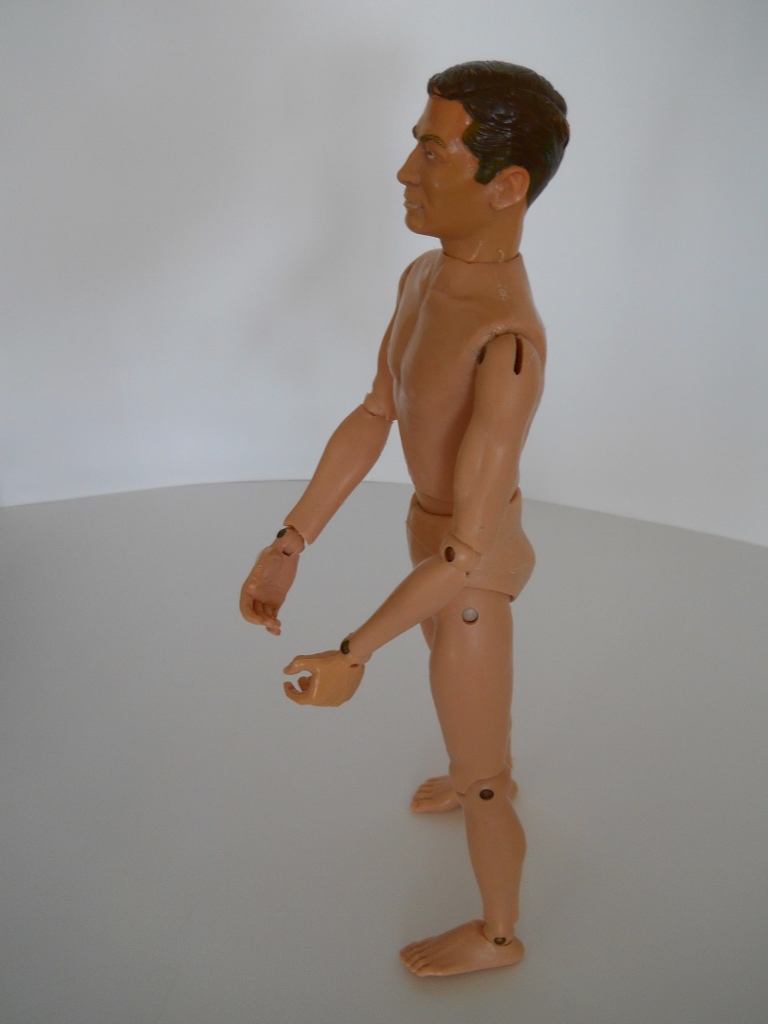

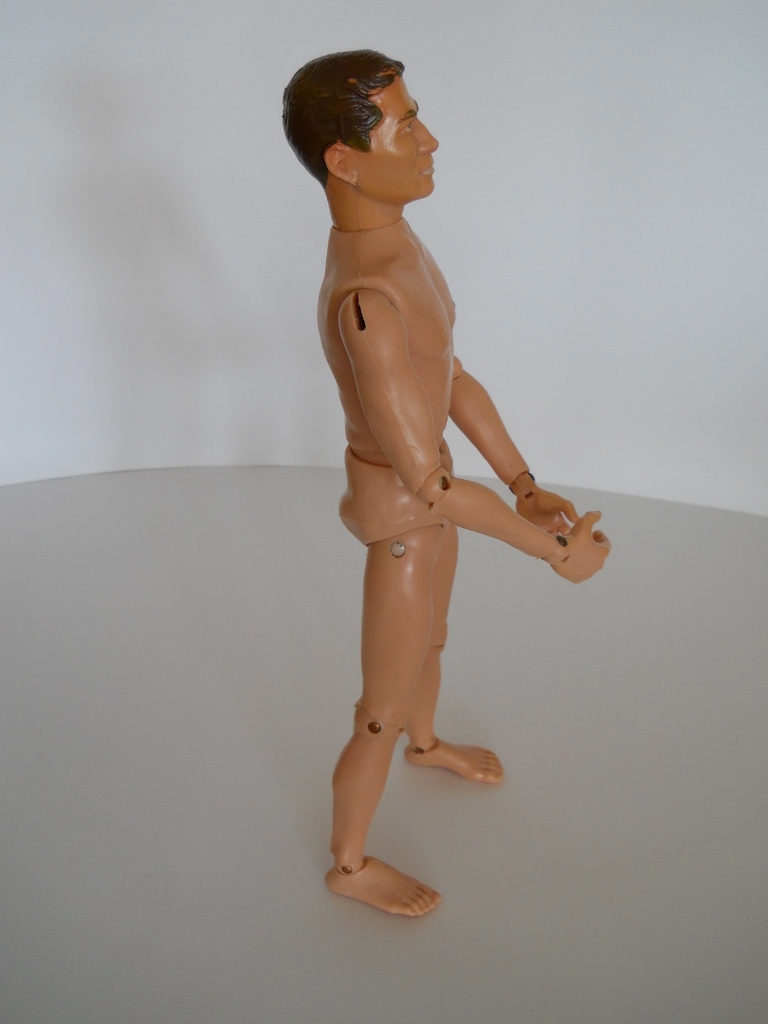
The similarities between the Marx All Canadian Fighter and the Marx All American Fighter are as follows:
Both action figures have virtually identical body parts; all of their limbs were modeled after the standard All American Fighter body (which, in turn, also closely resembled the Ideal "Captain Action" body construction). There may be some minor variation in terms of the texture and feel of the body parts, or the rubbery complexion of the hands, but the scale of the body parts and the assembled height of each action figure, from feet to shoulder level, is identical. The head was modeled after the same modified "Johnny West" and/or "Stony Smith" head then used prolifically by Marx on their 12-inch action figure line.
The series of photos directly below provides a close-up view of the various body parts, and of the rivets. By and large, the rivets on the All Canadian Fighter were an unpainted "bronze" or "copper" metallic hue. But, you can clearly see from the above photos that, for some reason, both of the upper thigh rivets on this figure were painted a "flesh" color by Marx-Canada. On other All Canadian Fighter figures, different rivets are often painted flesh-colored, while the thigh rivets could be left unpainted. There was no rhyme or reason as to which rivets Marx-Canada would paint and which they would leave unpainted.
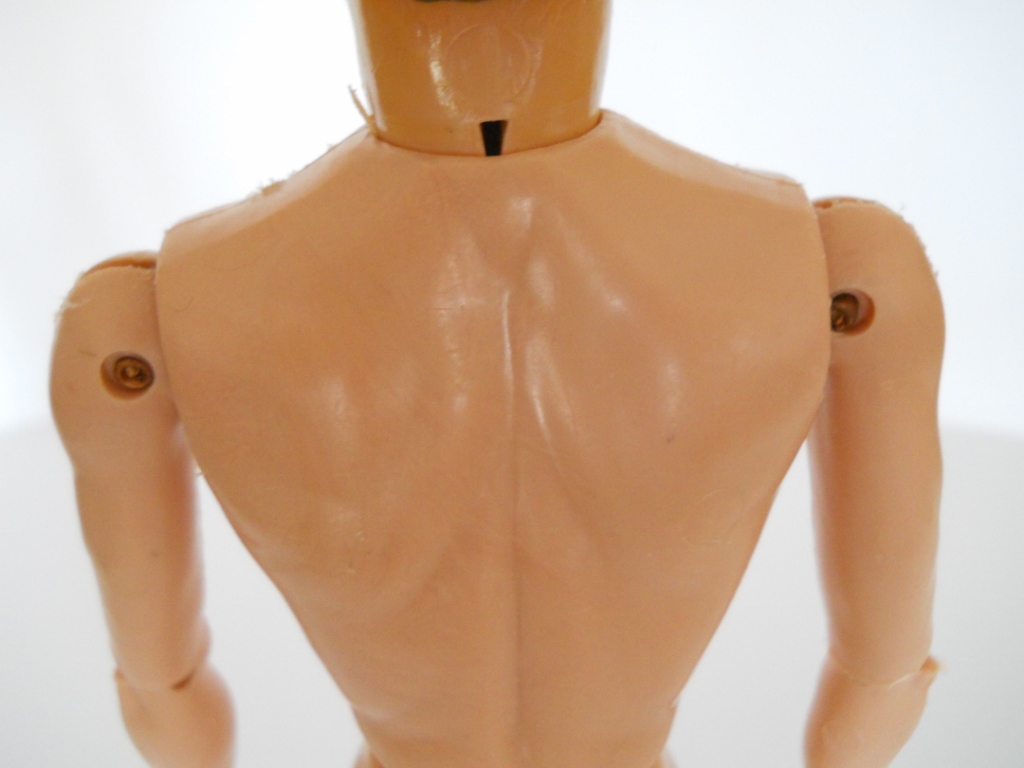
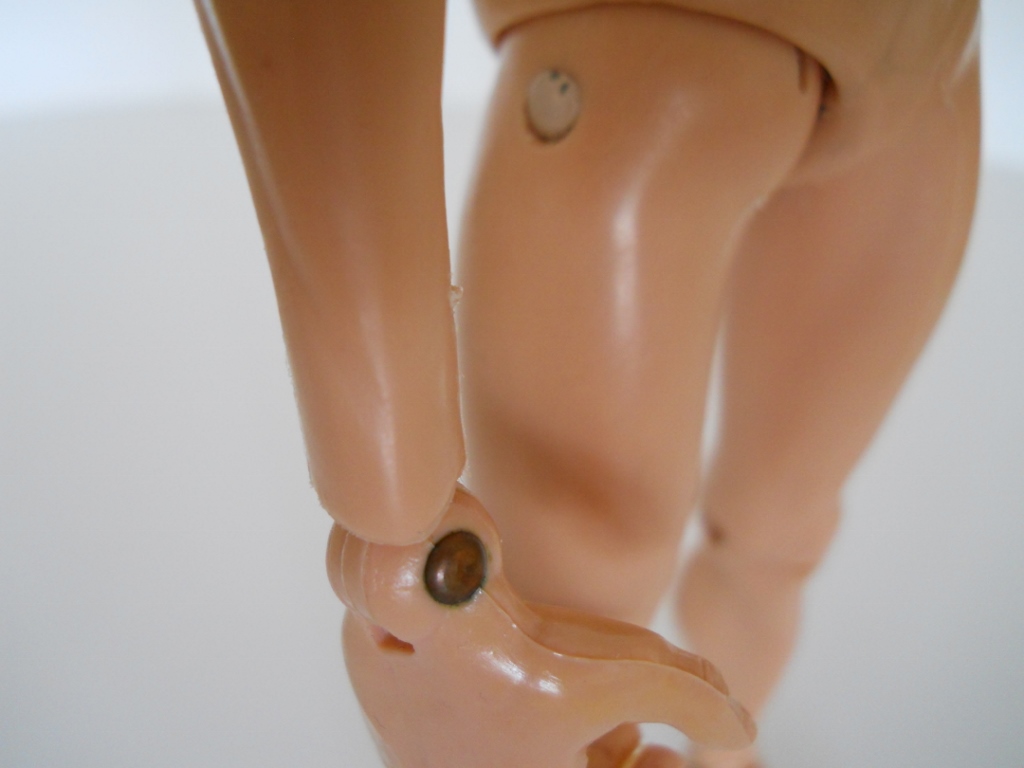
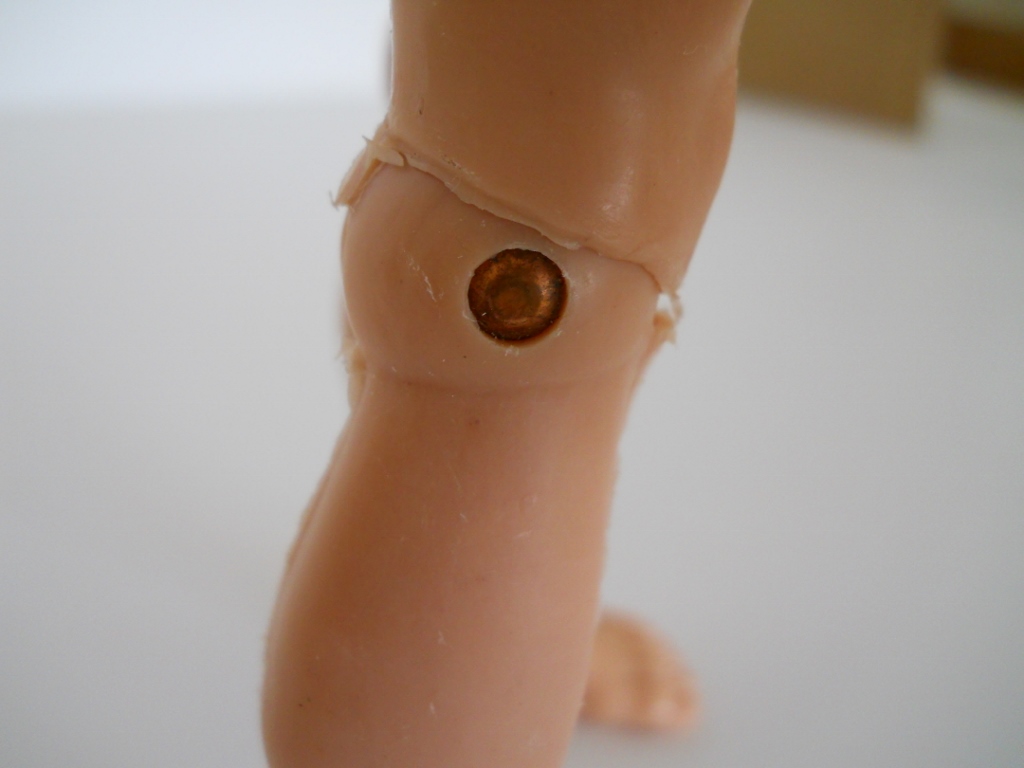
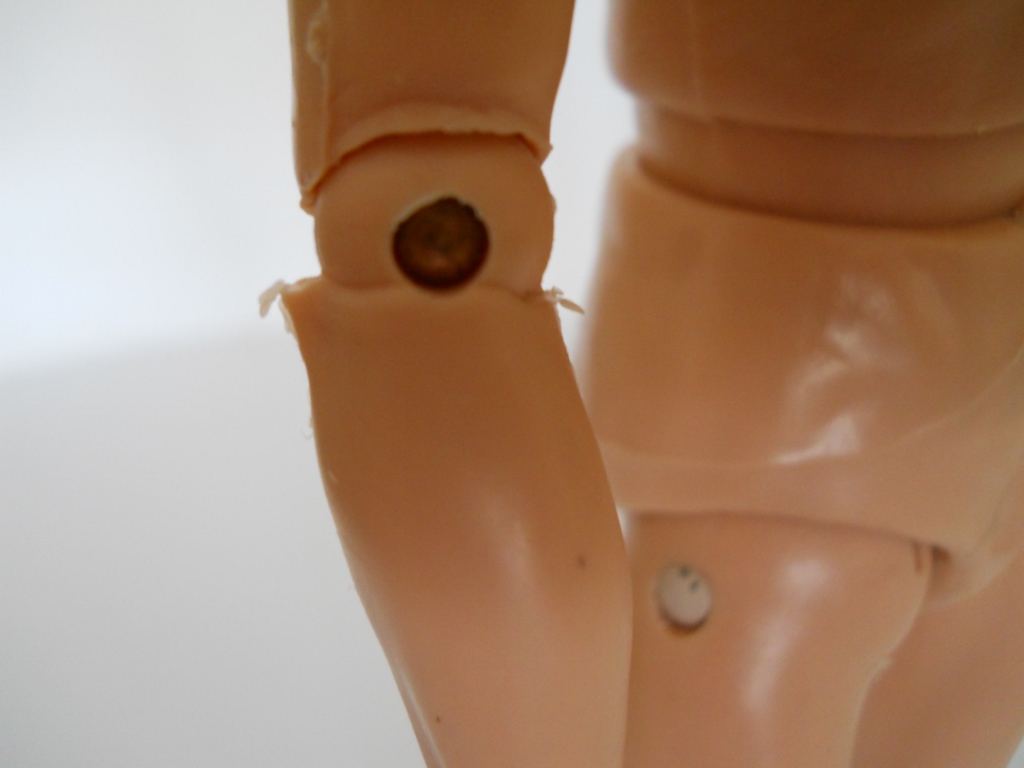
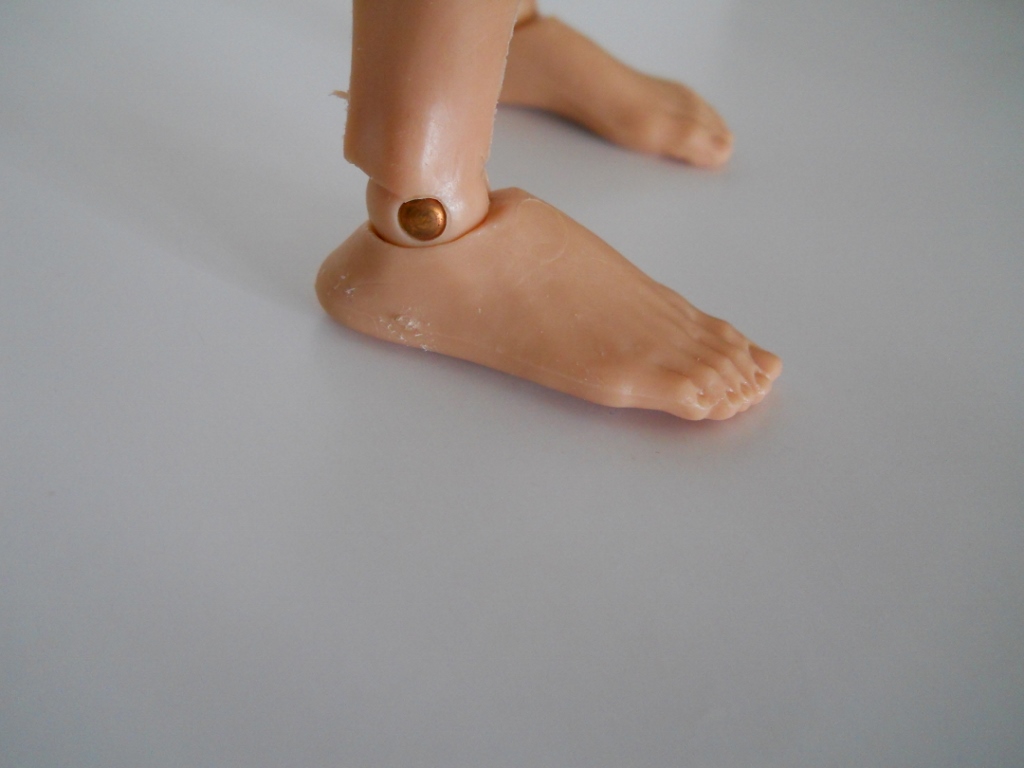
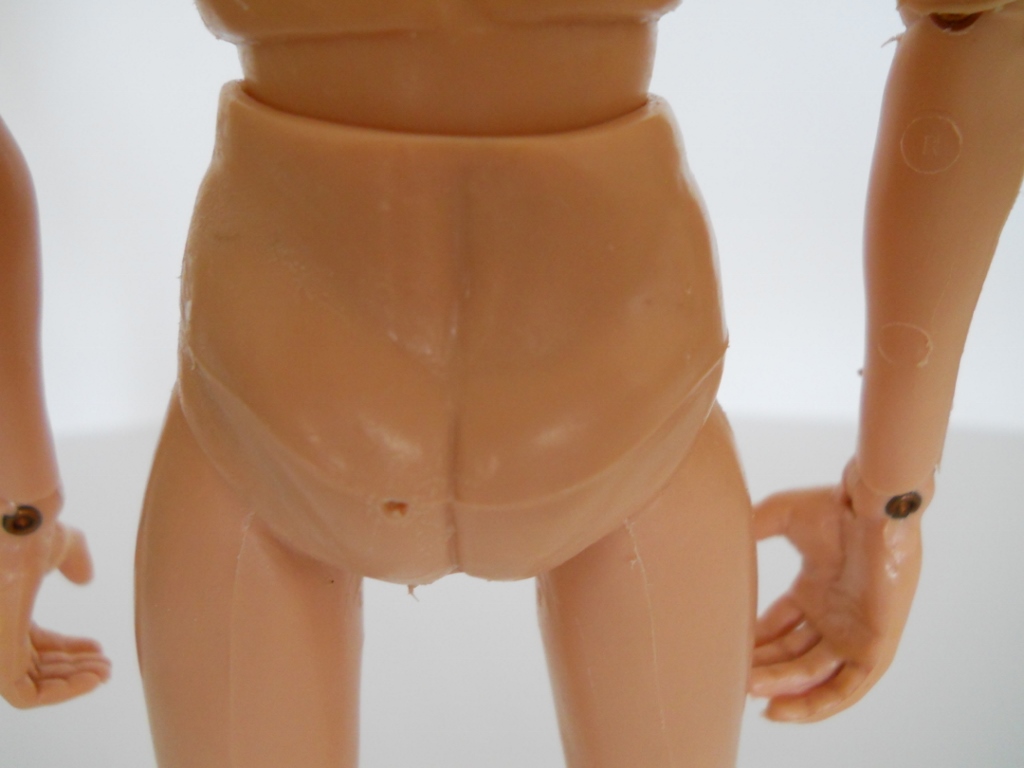
The first photo in the series above displays the back of his neck, with the standard circular Marx mold mark located there. This feature is a "blank" circular imprint and it does not contain the Marx Roman Numeral logo within it.
The next series of photos displays close-ups of the head of this figure.
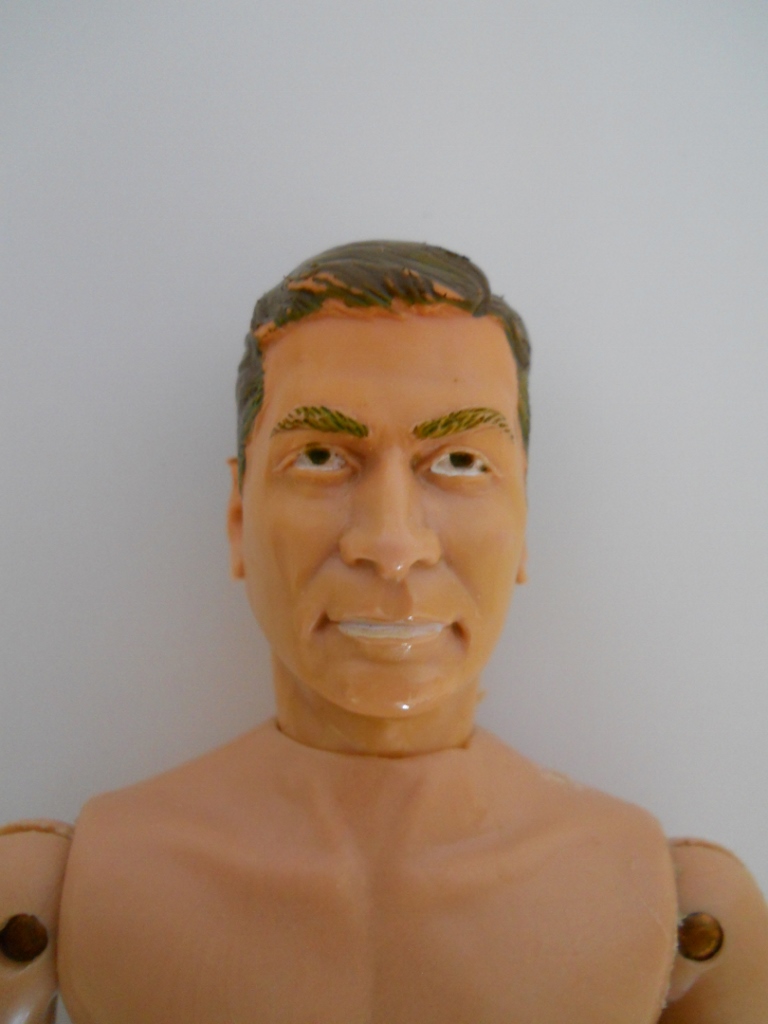

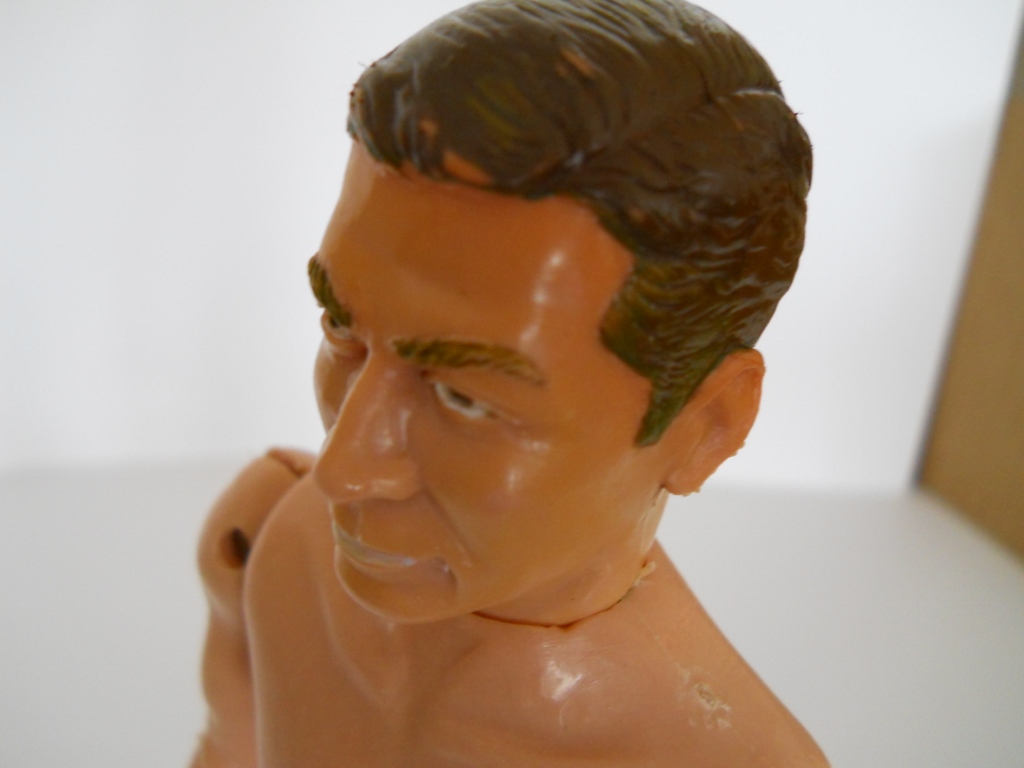
The above photos display the following head and facial features:
The hair is a somewhat light green-brown in color, with inconsistencies in terms of its application and depth of hue. In some places it looks distinctly brown, while in others it looks a shiny greenish shade. His eyebrows are colored different than his hair; I can only describe them as being a dark "mustard" color. His lips are a very "whitish" pink. The painted "whites of the eyes" on all of these figures tends to be a very prominent and defining feature.
A Direct Comparison to the All American Fighter
This next series of photos will compare the All Canadian Fighter to the All American Fighter.
The photo below shows the Marx All Canadian Fighter on the left and the All American Fighter on the right. Note the darker skin tones on the face of the All Canadian Fighter.
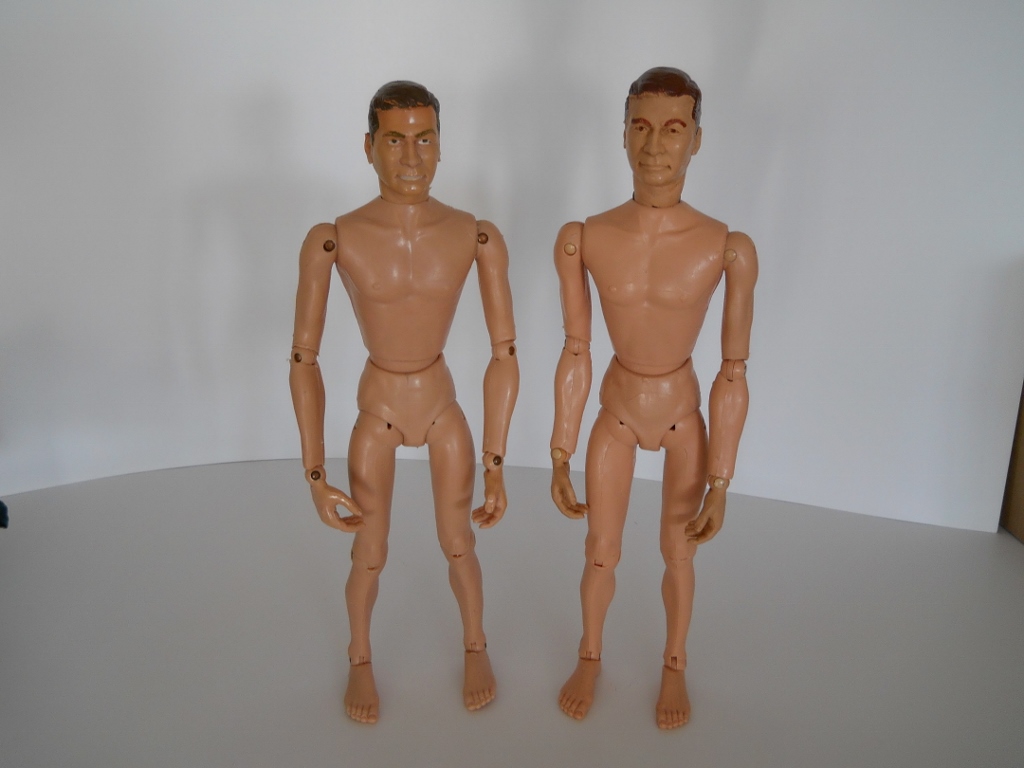
Although there "appears" to be a height differential between the two figures (with the American Fighter being taller), this is only an indication of how far into the body the head pin component is sunk. The next photo shows that the height discrepancy is due solely to this factor and the two fighters are, otherwise, identical in terms of their height.
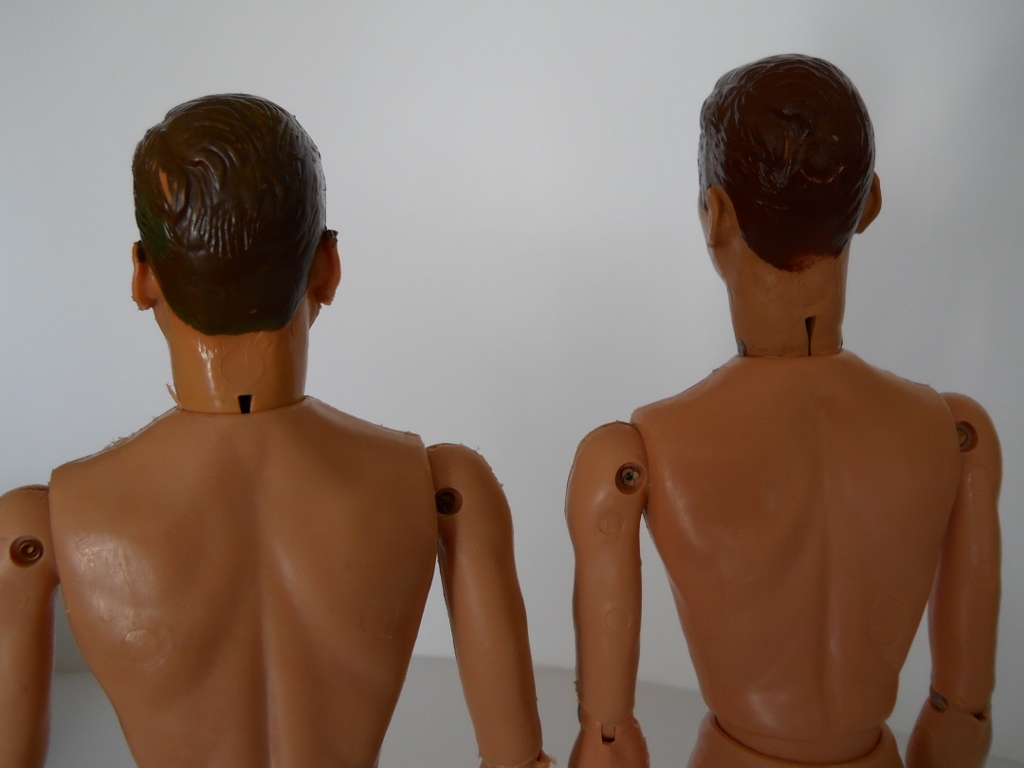
The next two photos more closely examine the differences in the facial appearance of the two individual figures.

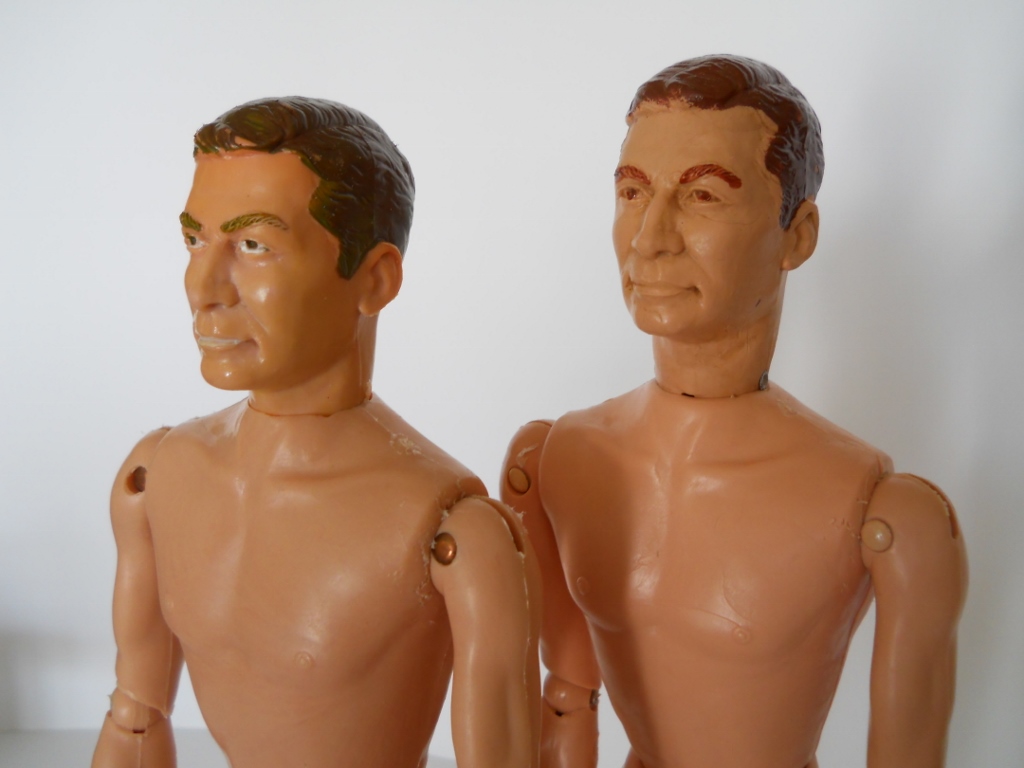
Note the following features with respect to the All American Fighter figure (to the rear): reddish-brown hair and eyebrows; painted rivets; lack of painted lips; lack of paint to the whites of the eyes; no tanned looking face.
However there are other similarities between the two figures, too. Note the presence of the nipples on the chests of both figures in the photo below.

But one additional minor variation exists when examining the backs of the two figures. The first photo below shows the back of the All American Fighter figure with a prominent Marx logo heat-stamped into the center of the circle located there. It reads: "Louis Marx & Co. Inc.; C.; MCMLXV" (the Roman numeral date reads 1965). The second photo shows that the back of the All Canadian Fighter bears no such stamp and only displays two of the vacant circular mold marks, one on each shoulder blade.

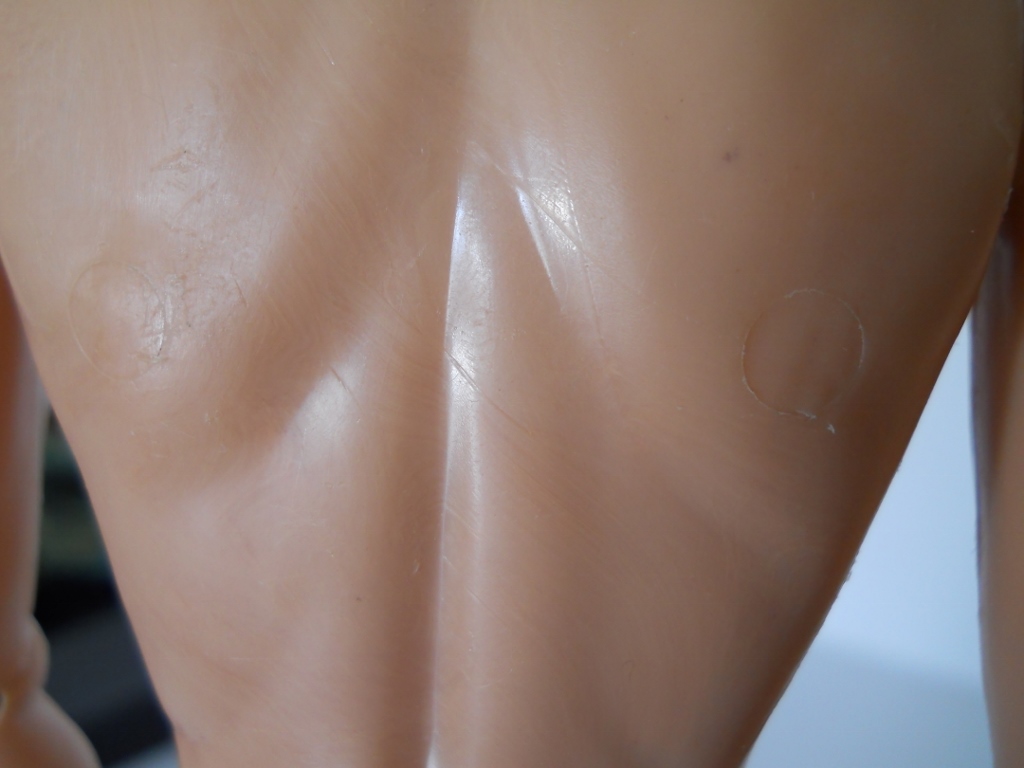
The Original Marx Buddy Clothing and Equipment
The Marx All Canadian Fighter "Buddy" figure originally came with 16 individual clothing and equipment items. They are illustrated below, alongside of the action figure.
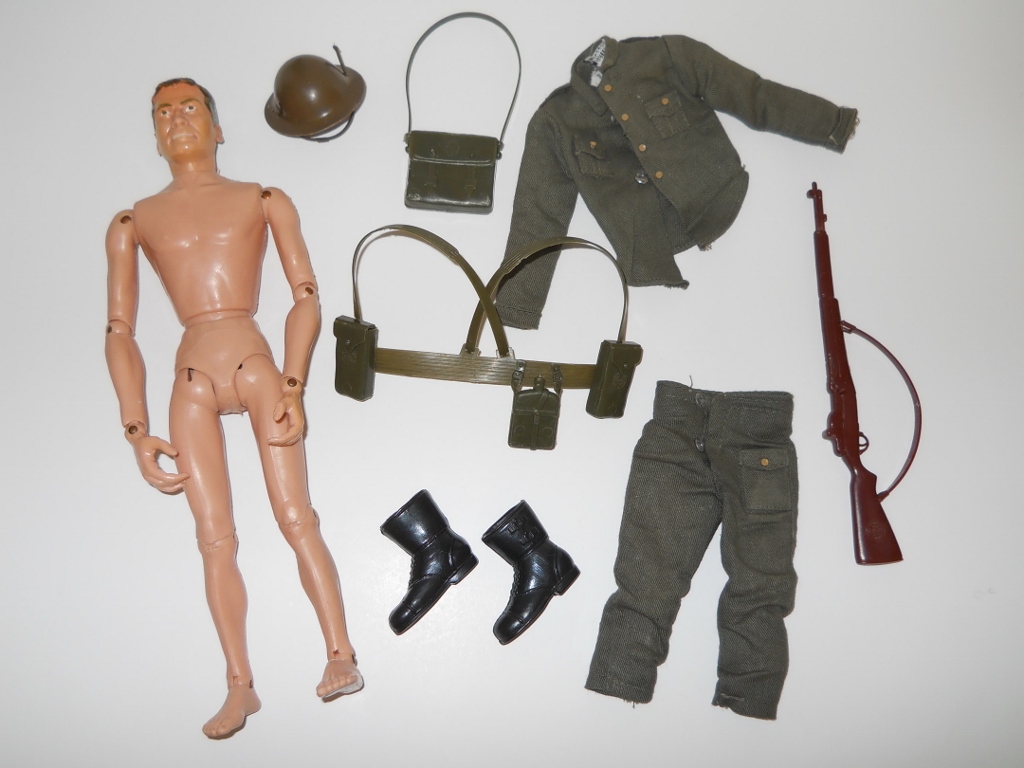
I will now proceed to give the reader a proper itemized list, and detailed description, of the 16 accessory items included with each of the Marx Buddy figures.
The Sixteen Marx Buddy Clothing and Equipment Items
Here is a listing of the 16 Marx Canadian Buddy accessories.
1 Green olive-drab cotton drill Army shirt with epaulets and 6 tiny "tan" colored front buttons; 1 Green olive-drab pair of cotton drill Army pants with 1 tiny "tan" front pocket flap button; 1 Chocolate Brown colored hard plastic M-1 rifle with Marx logo on the butt; 1 Chocolate Brown rifle strap with square strap "rings;" 2 soft, rubbery plastic Black Army Boots with side straps molded onto the outside of the boots (individual "left" and "right" boots); 1 Dark Tan colored WWII Army helmet; 1 Dark Tan chin strap; 1 Green plastic courier pouch with Marx logo on front flap; 1 Green plastic shoulder strap for the courier pouch; 1 Green plastic Army web belt; 2 Green plastic shoulder straps that attach to the web belt; 2 Green large plastic pouches that slide onto the web belt; 1 Green plastic canteen that clips onto the web belt.
We will now examine these individual equipment and clothing items much more closely.
1.) The Army Shirt and Pants
As already indicated, the shirt had six tiny tan buttons sewn onto it, four down the front flap of the shirt and two more on the breast pocket flaps. The shirt contained an embroidered cloth tag which read "All British Fighters, by Marx, Hong Kong." (I apologize for the fact that the tag on the photo of the shirt below has been cut.) The shoulders had epaulets on them. The shirt contained "round" metal closure snaps, different from the square metal snaps found on some All American Fighter uniforms.
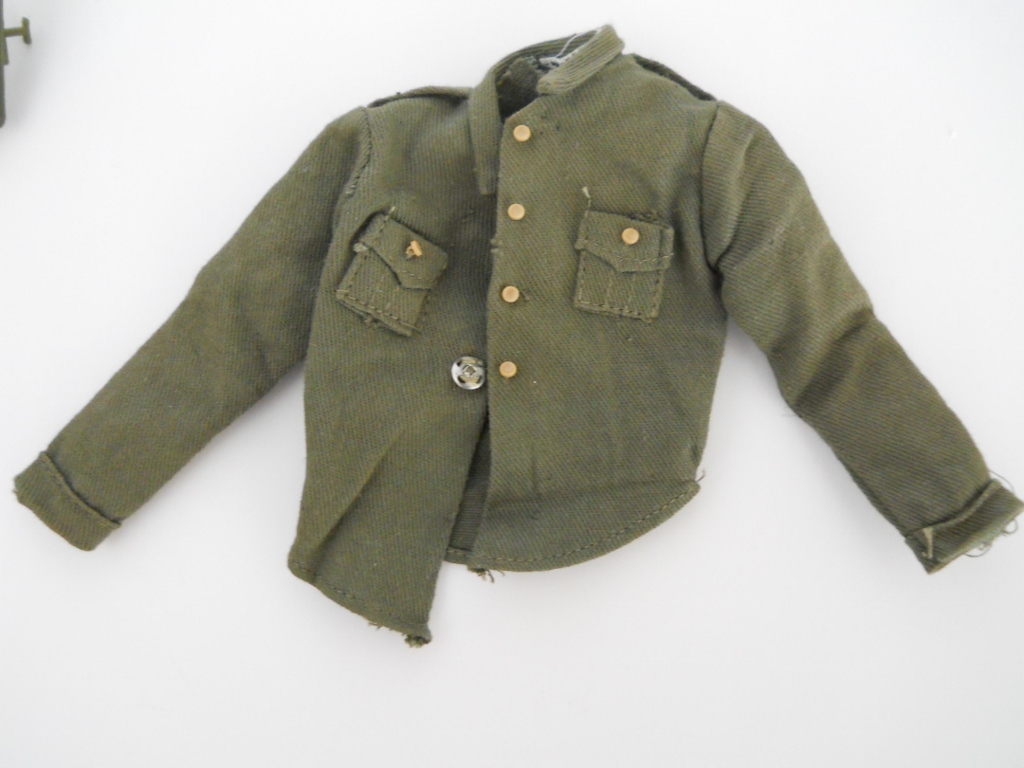

The shirt sleeves had cuffs sewn onto them. A close-up of the tan buttons below reveals how they were attached.
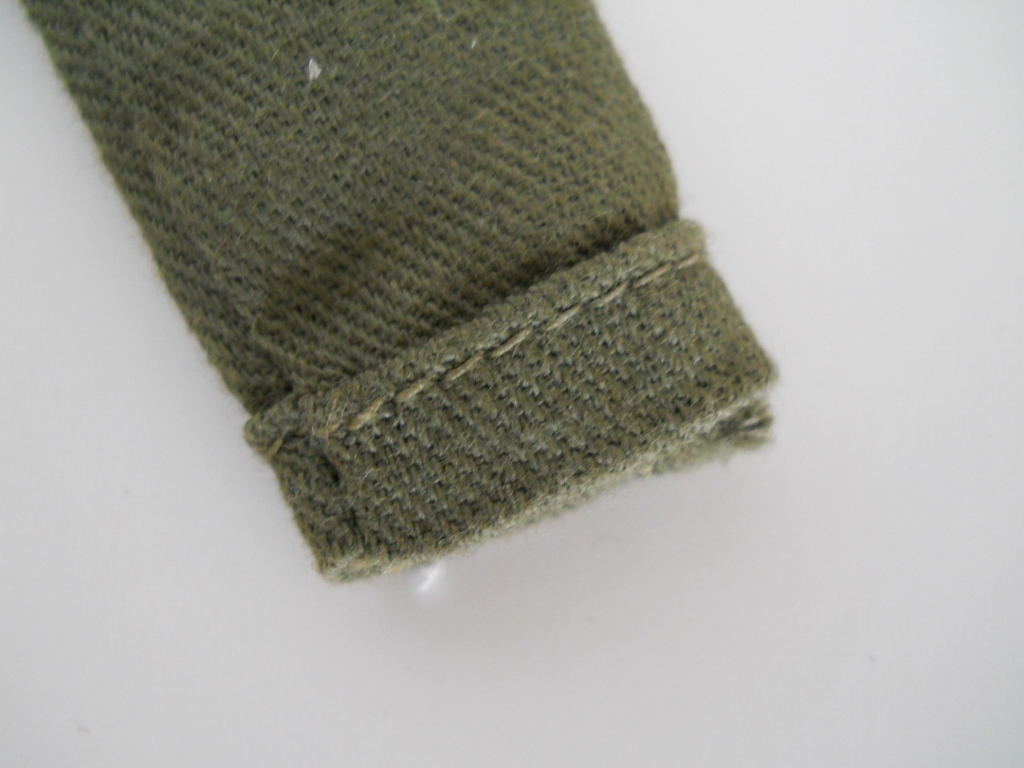
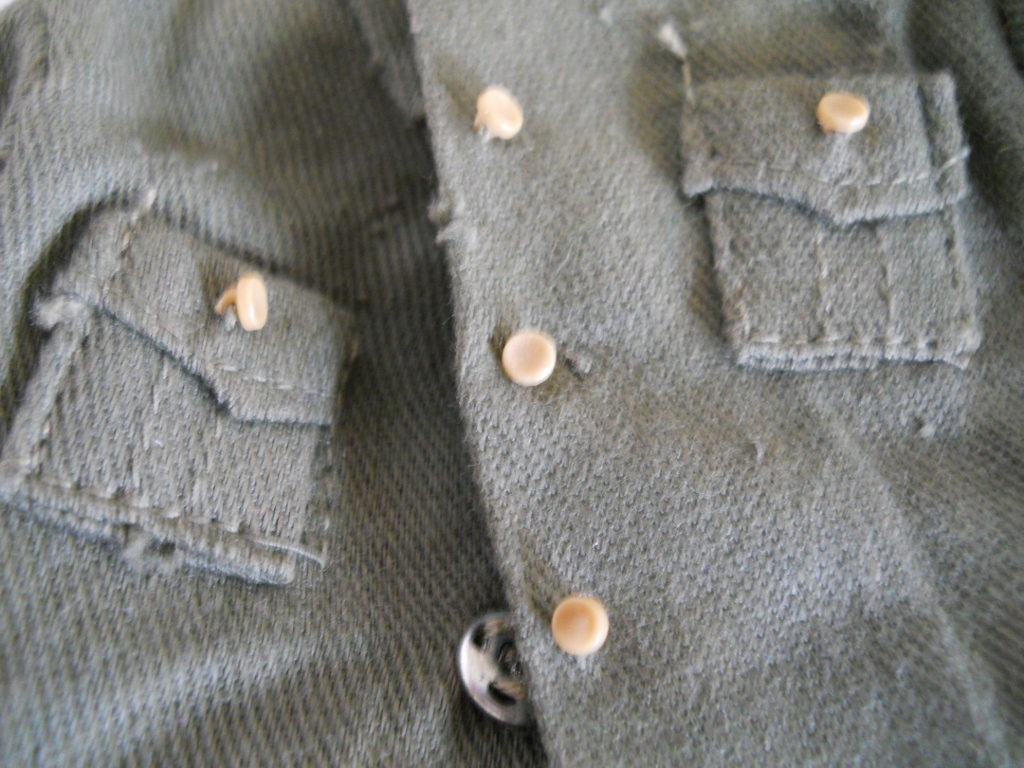
The pants had only one tiny tan button sewn onto the front pocket flap, but the pants were also tagged with an embroidered cloth tag.
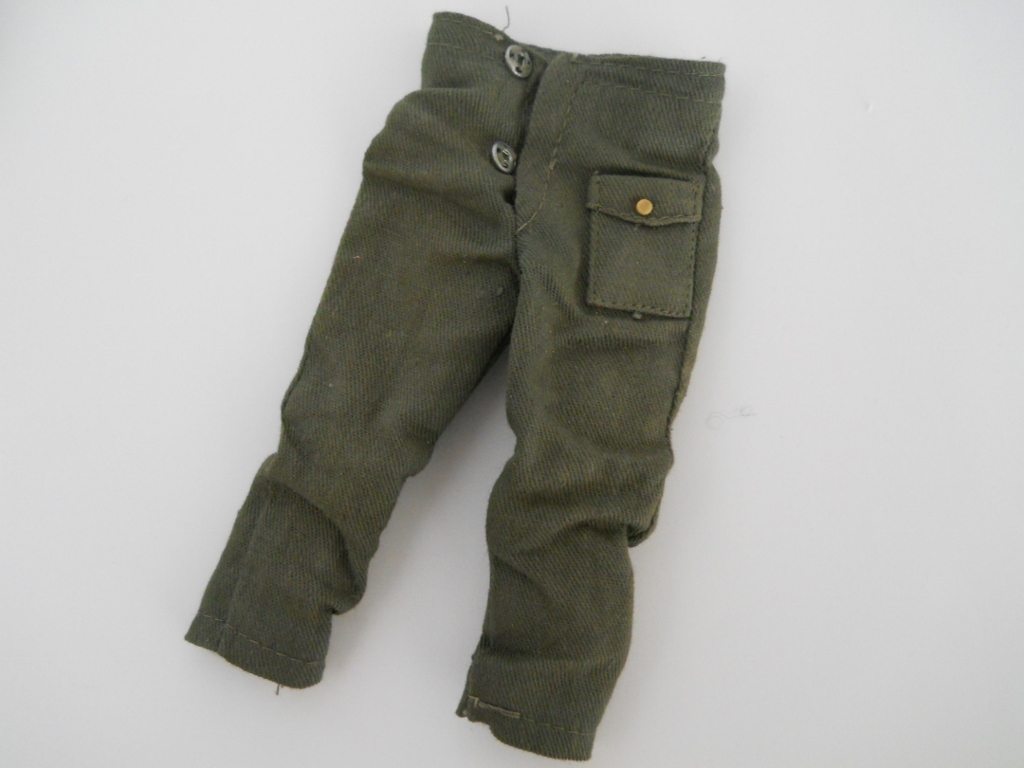

The reverse side of the All Canadian Fighter shirt and pants set is displayed on the left below. Next to it is a comparison photo of the All Canadian Fighter uniform adjacent to a standard All American Fighter olive-drab shirt and pants set. Note the differences in both the colors and cut of the fabric.
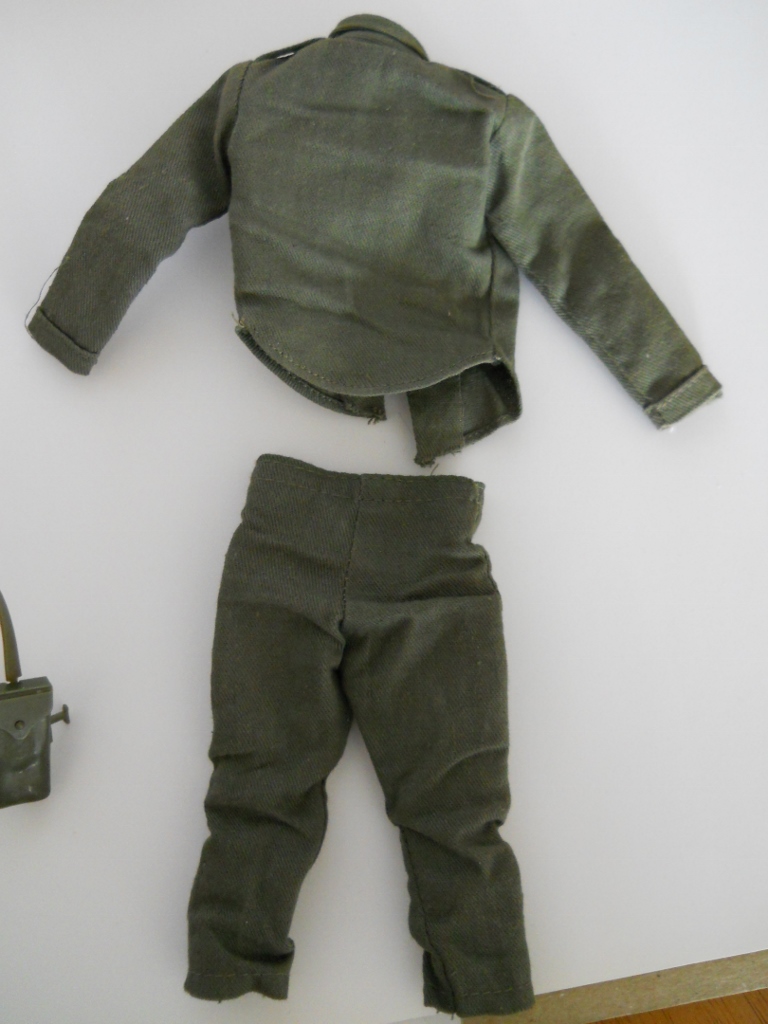

The following picture on the left shows a comparison of the front of the pants for the two different uniforms and the photo to the right shows how the All American Fighter outfits were tagged as compared to the All Canadian Fighter uniforms. Note that the All American Fighter outfits were tagged "Made in Japan" while the All Canadian Fighter uniform was "Made in Hong Kong."

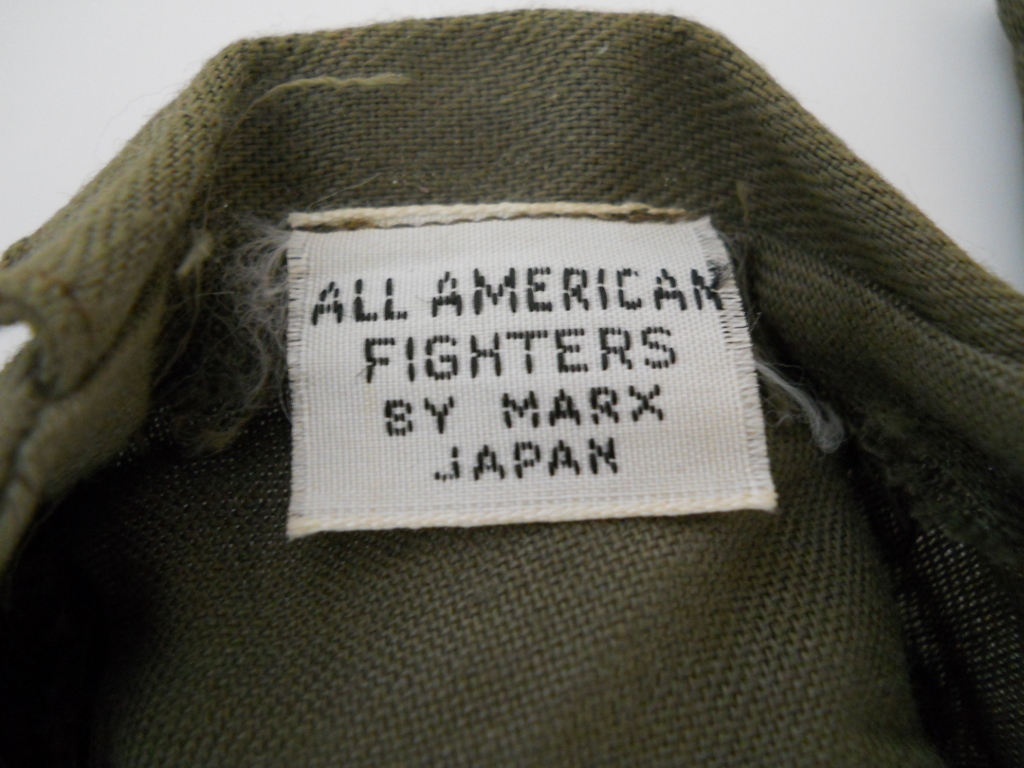
2.) The Black Boots
Below are two photos of the soft, rubbery Marx All Canadian Fighter black boots. Note that they contain individual right and left orientations and that there are "side straps" molded onto the outside exterior of each boot.
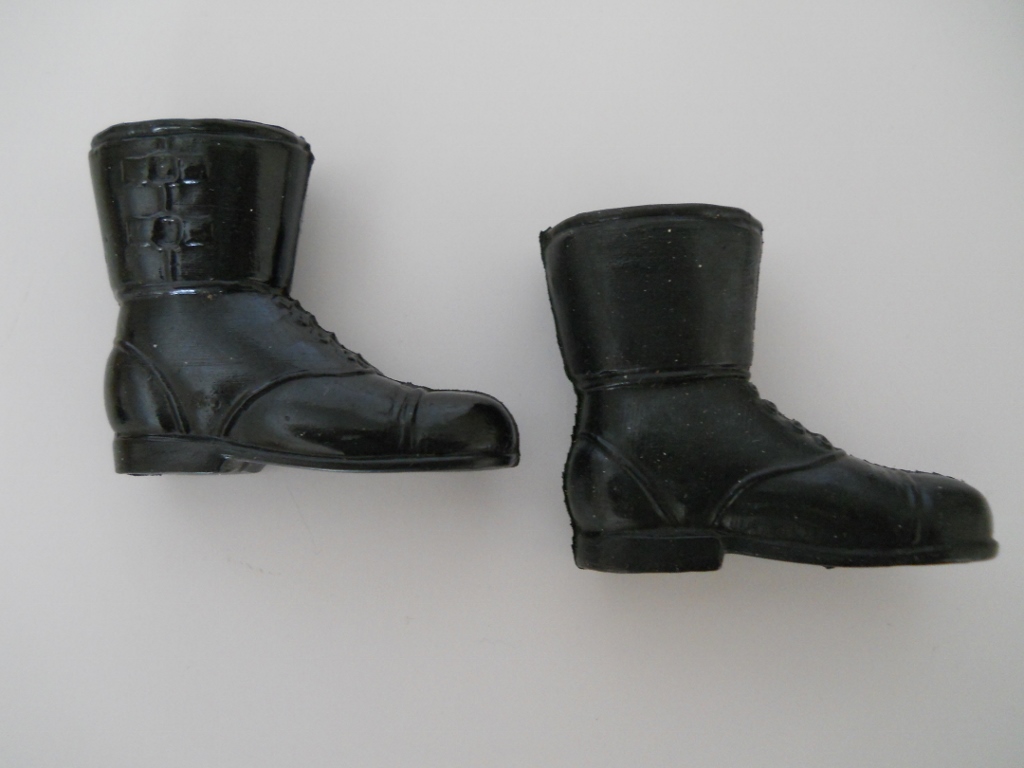

3.) The Chocolate Brown M-1 Rifle
Below are a series of photos of the chocolate brown colored Marx M-1 rifle with rifle strap. This "hard plastic" rifle is molded from much the same type of material as a breakable Hasbro GI Joe M-1 rifle, and not the soft, pliable plastic composition of, say, a Stony Smith M-1 rifle. Note the presence of the Marx logo on the rifle butt on each rifle.
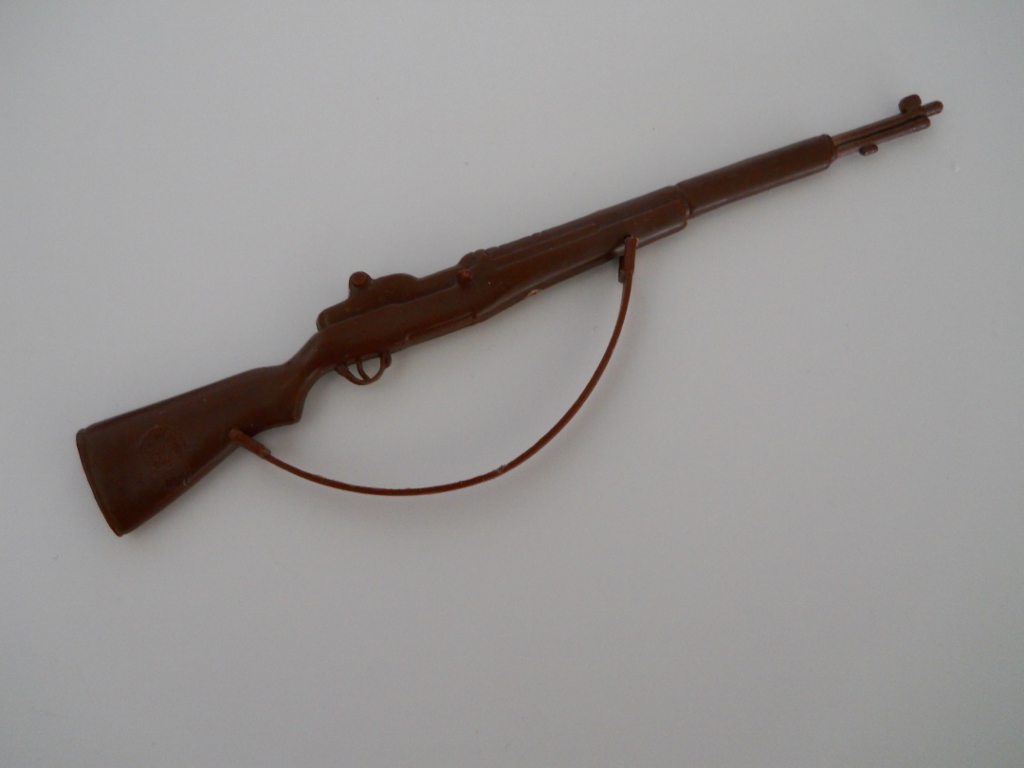
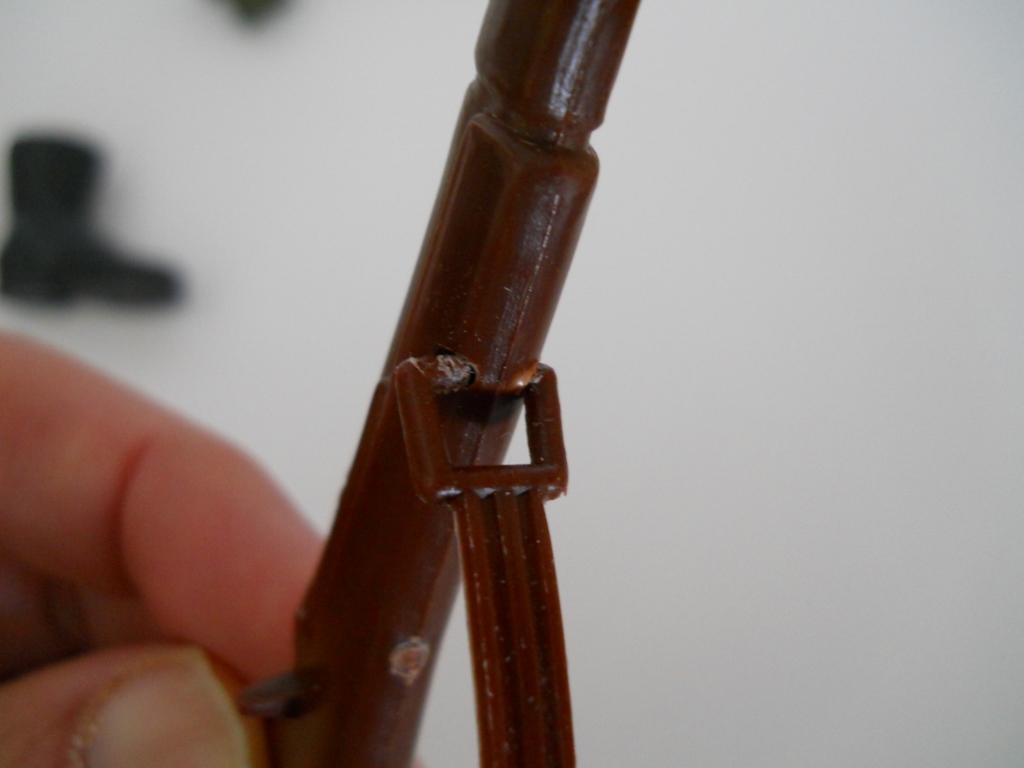

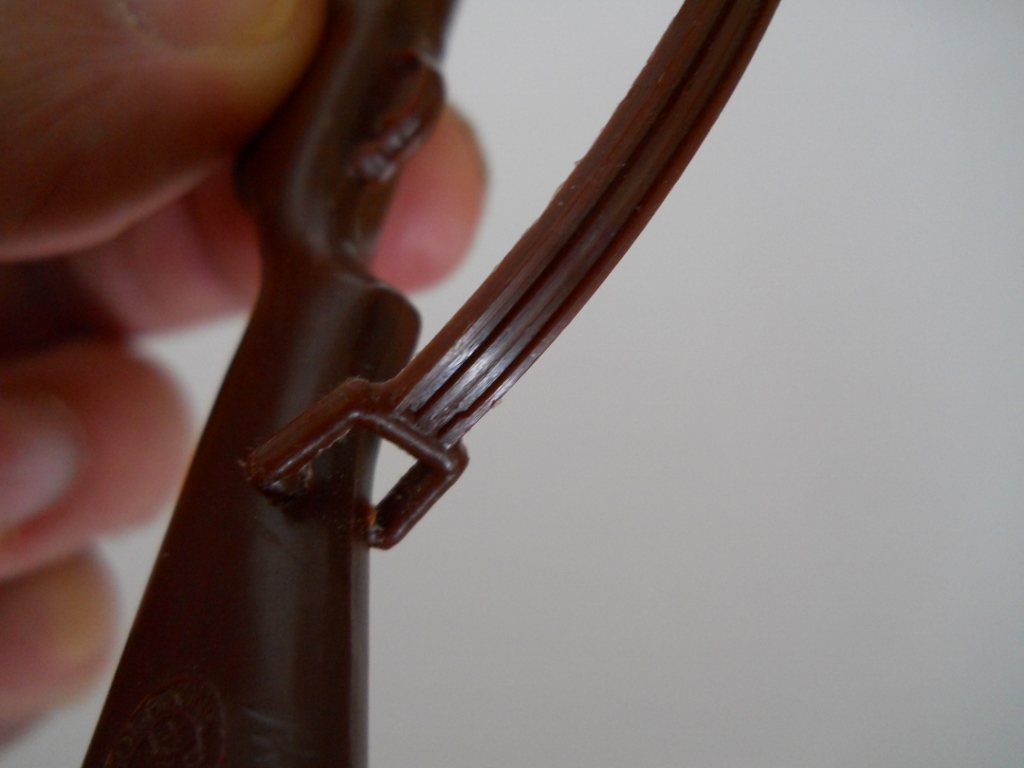
4.) The WWII Helmet and Chin Strap
Shown below is the greenish-brown "dark tan" helmet and chin strap. Next to it is a photo of the Marx logo that can be found inside the top of the helmet.
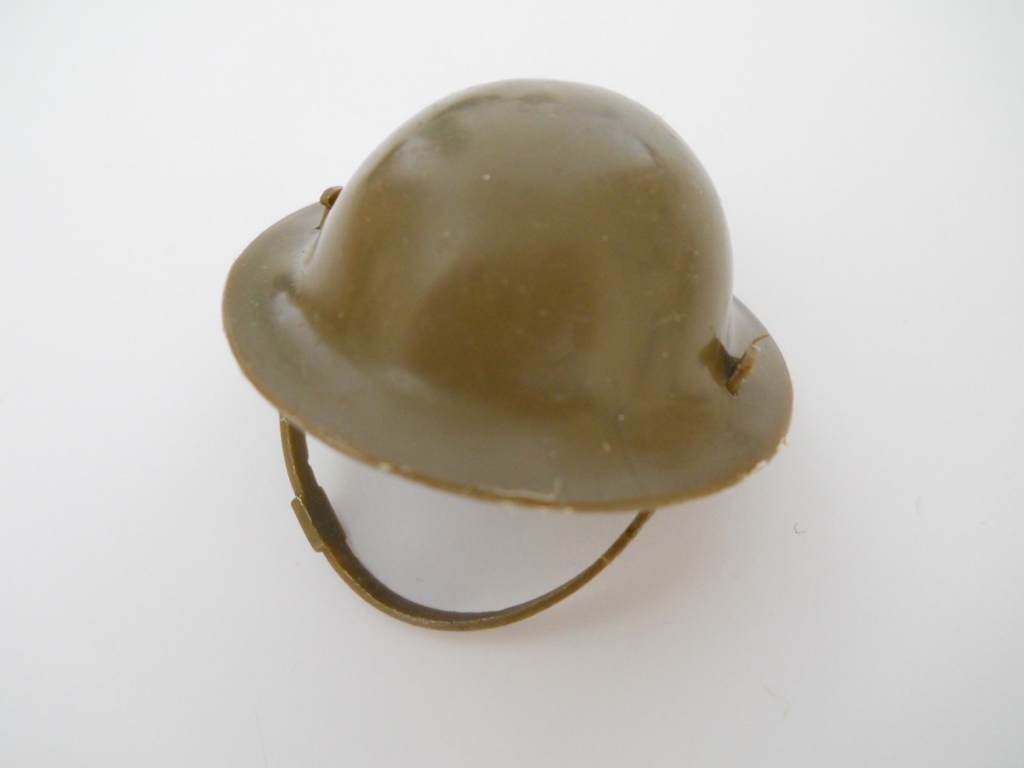

5.) The Green Plastic Accessories
Shown below is a photo of the 8 individual green plastic accessories (displayed with the M-1 rifle and the helmet). Although the belt has been full assembled, note that the pouches, canteen and shoulder straps can be easily removed and then re-attached at will. The shoulder strap on the courier pouch is also removable.
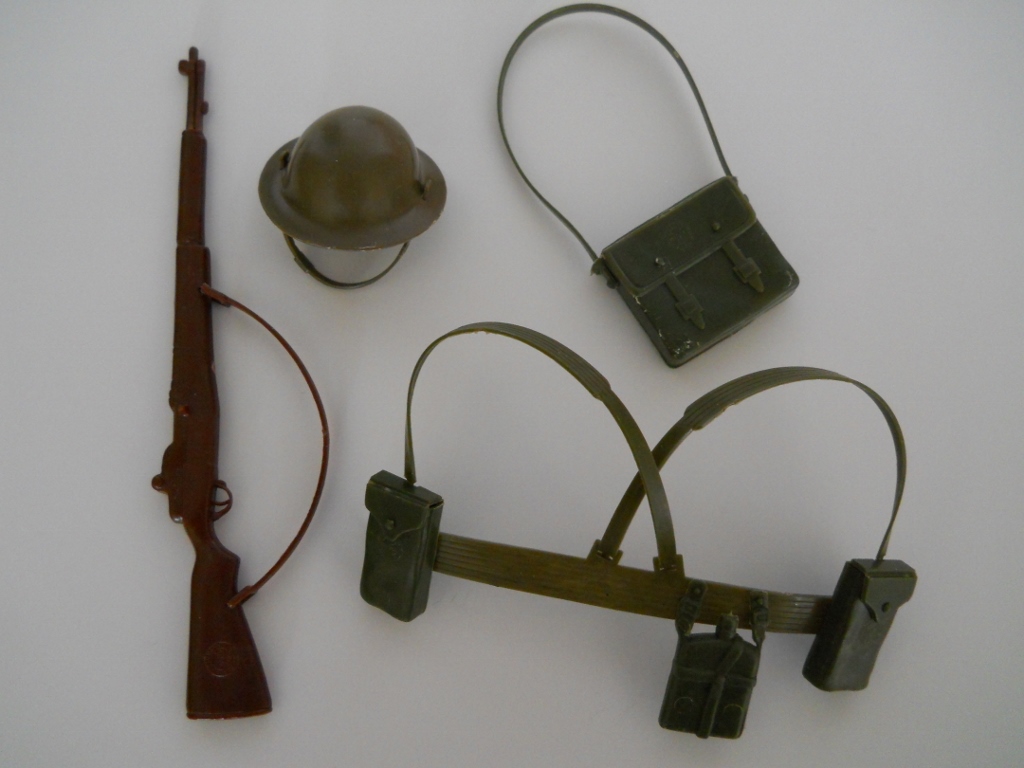
Note the Marx logo on the front of the courier pouch (shoulder bag).
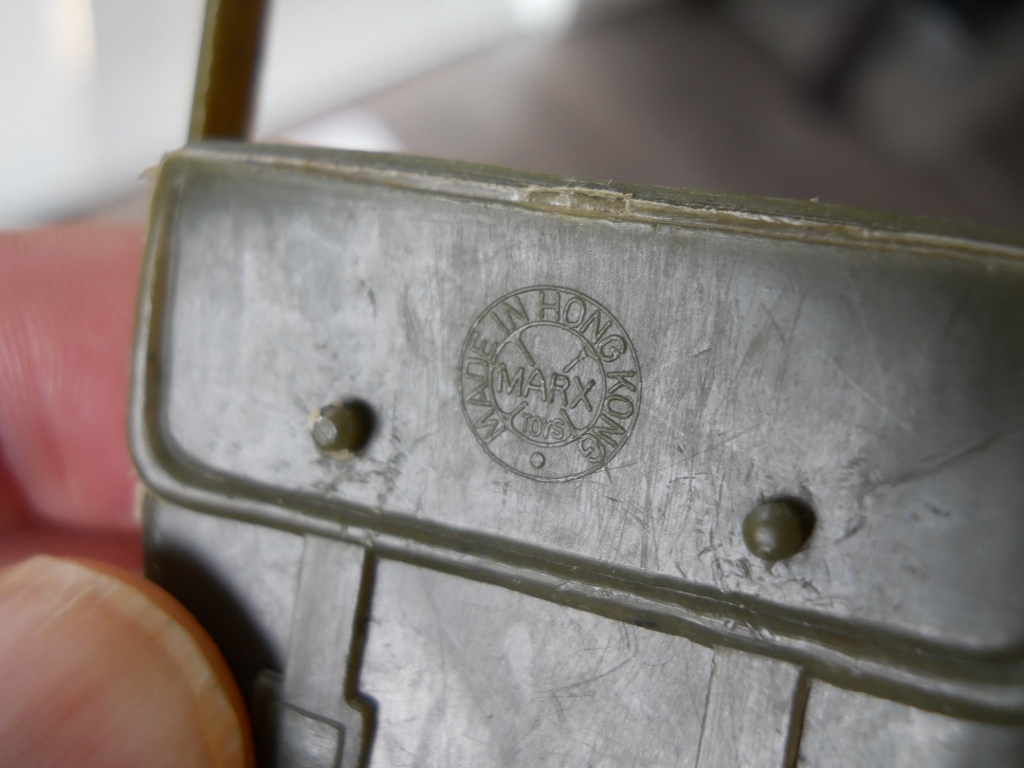
Illustrated below are 12 of the Marx All Canadian Fighter accessories (shown on the left) next to a sampling of 12 Stony Smith (or All American Fighter) accessories. Note the differences in color and composition.

And now, it's time to look at the fully dressed figure. The following photos give you a complete view of the fully equipped soldier, ready and poised for combat action.
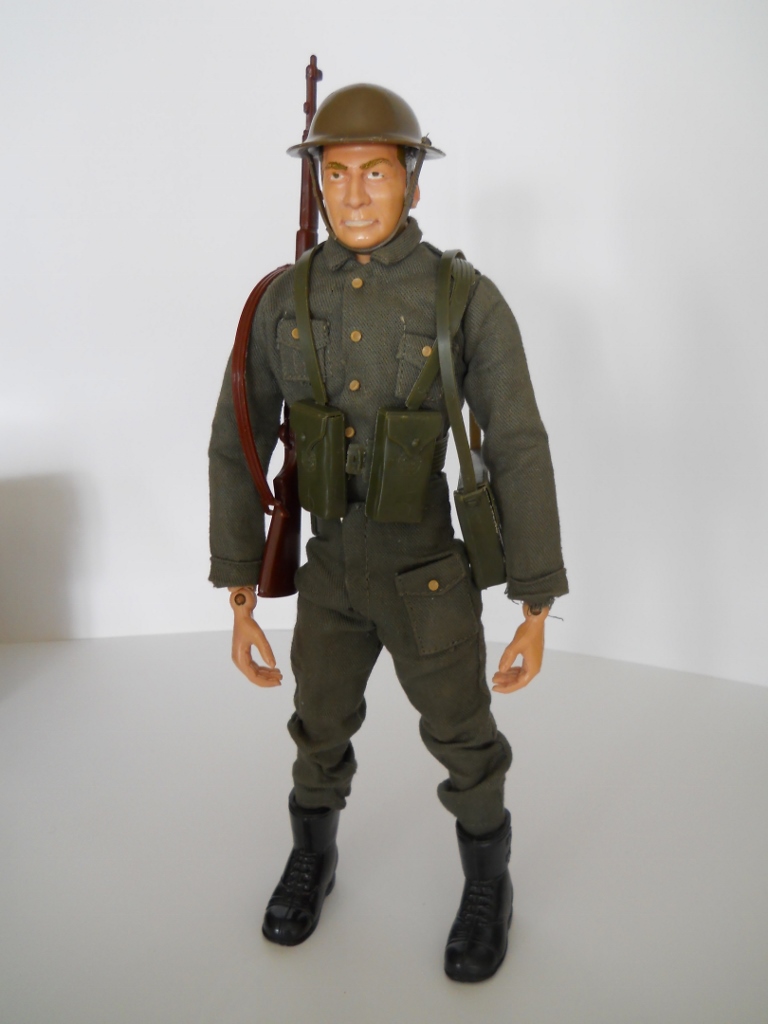
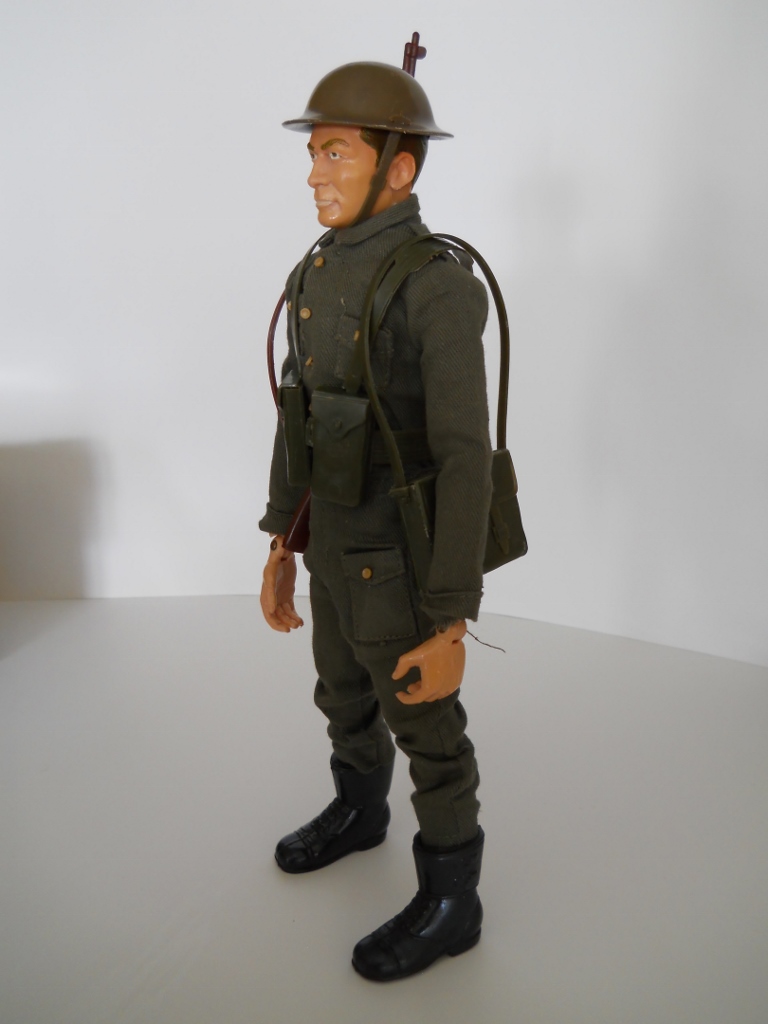

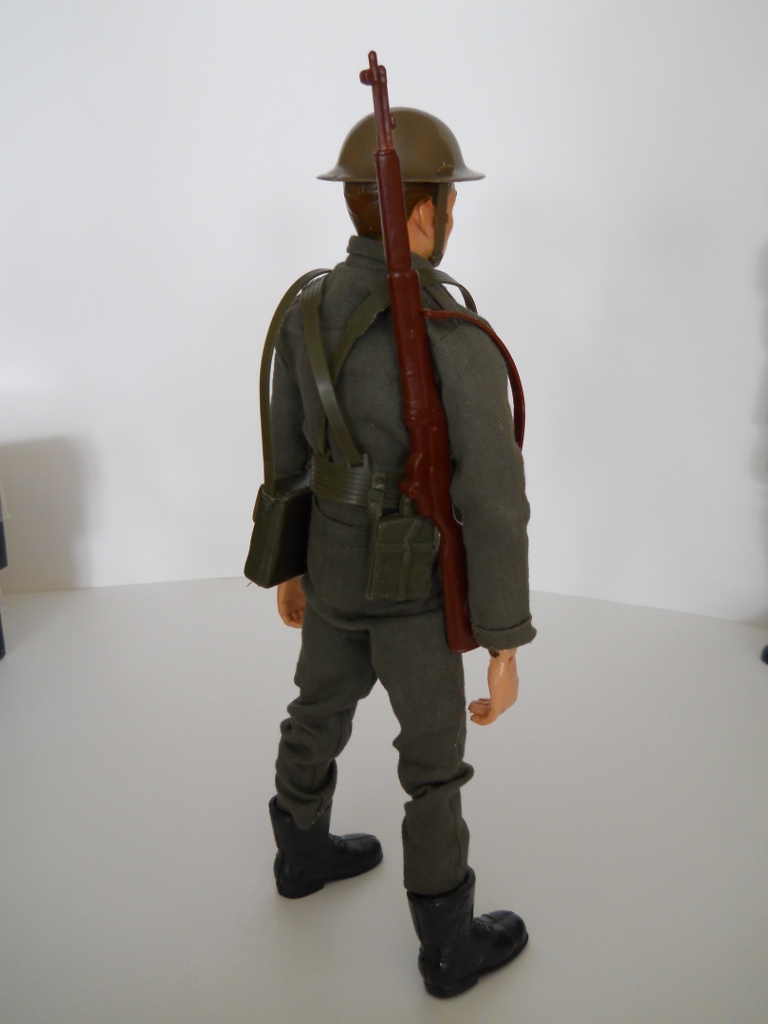
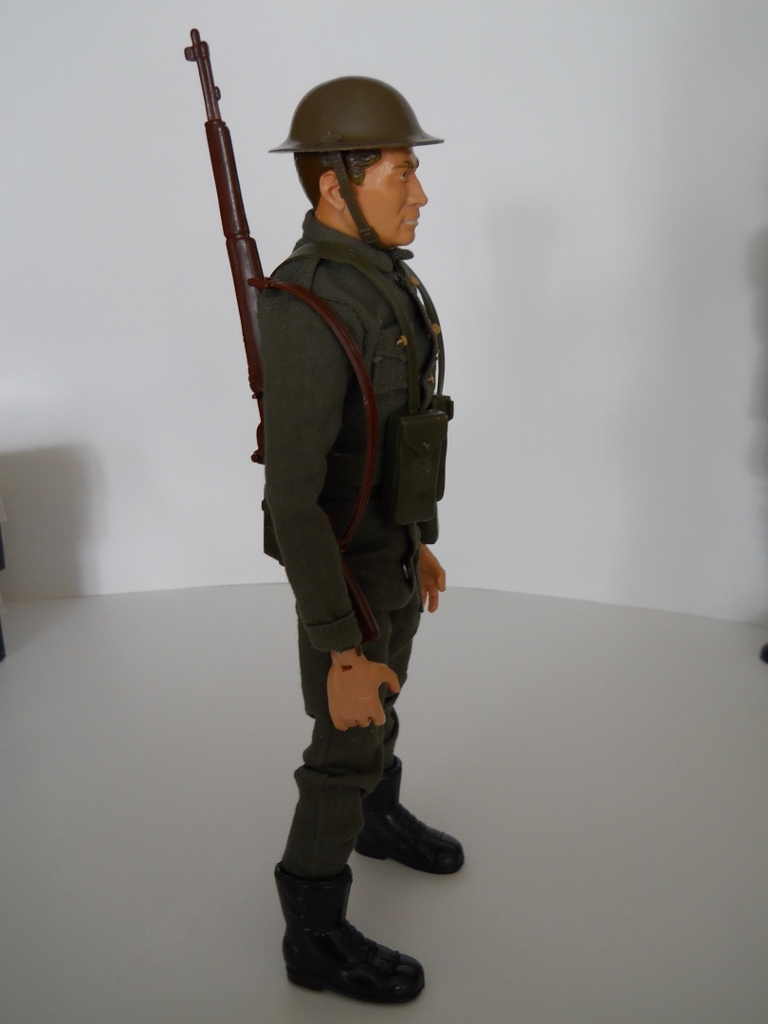
The Marx All Canadian Fighter Jeep
The Jeep that the Canadian Buddy figure was matched with in the 1967 Simpsons-Sears Christmas catalogue was a standard-issue Marx Jeep, identical in both Canada and the USA. The pictures that follow illustrate the Jeep that came with the above pictured Marx Buddy figure when I acquired him. Other than for a broken and missing front bumper, the Jeep pictured below is complete.
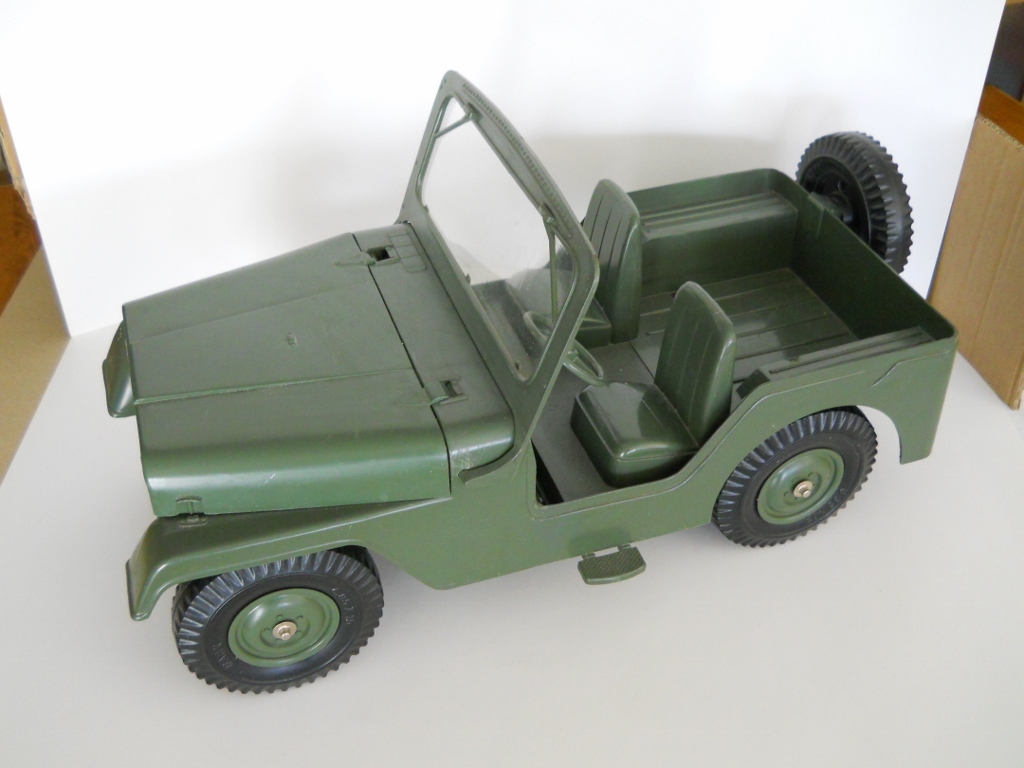
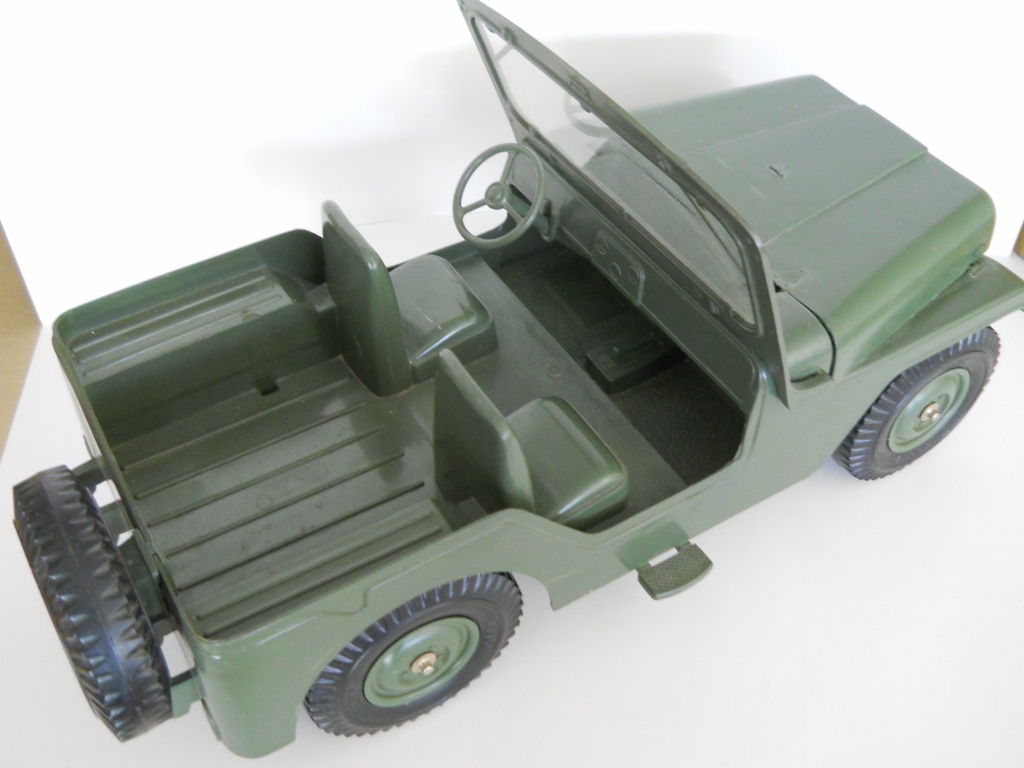
The Boxed Marx Buddy, The All Canadian Fighter
None of the Marx Buddy figures in my collection came boxed and, thus, I am not an expert on the boxed versions. A number of years ago, there was a boxed figure that appeared on eBay and this is the only manner in which I was able to acquire some photos of the vintage box for this figure. Thus, I can make no claims as to the authenticity of the box shown, but I do believe it to be authentic, as the staples in the sides of the box were indicative of the 1967 era, and, the writing on the end of the box that indicates it was "Made in the British Crown Colony of Hong Kong" does correlate with the country of origin cloth tags inside the figure's uniform.*
*(I have recently been informed of the identity of the original poster of the photos, shown below, of the "boxed" Buddy figure and I would like to extend my sincere thanks to Mr. Sebastien Cauchy for the privilege of being able to share them with you. Also, check out Mr. Cauchy's website at https:/www.CauchysAntiques.com to view many more interesting vintage toy and collectible auction items, online now, too.)


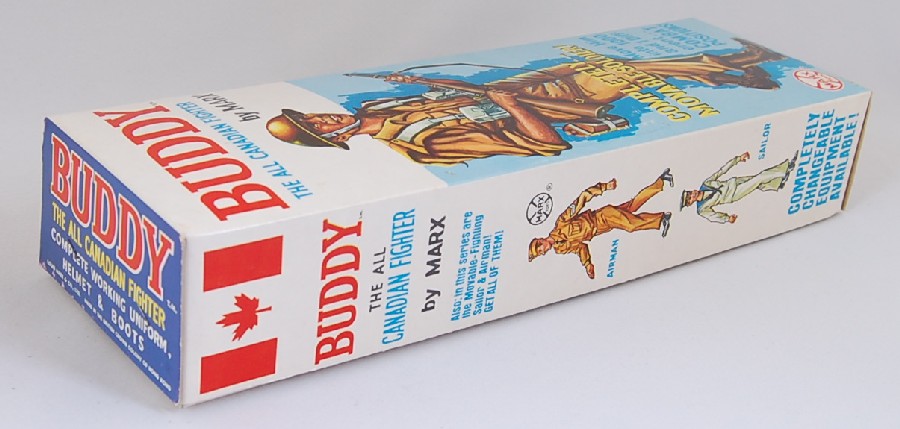
(Note: The action figure shown next to the box in the first picture above is not the Marx Canadian Buddy figure that I own, but all of the other close-up photos contained on this site are of the figure that I have in my collection.)
The 1967 Simpsons-Sears Christmas Catalogue (Catalog)
Illustrated below are photos of the front cover of the 1967 Simpsons-Sears Christmas catalogue and page 182 of the catalog in black and white that features the Marx Buddy figure standing next to the Marx Jeep.
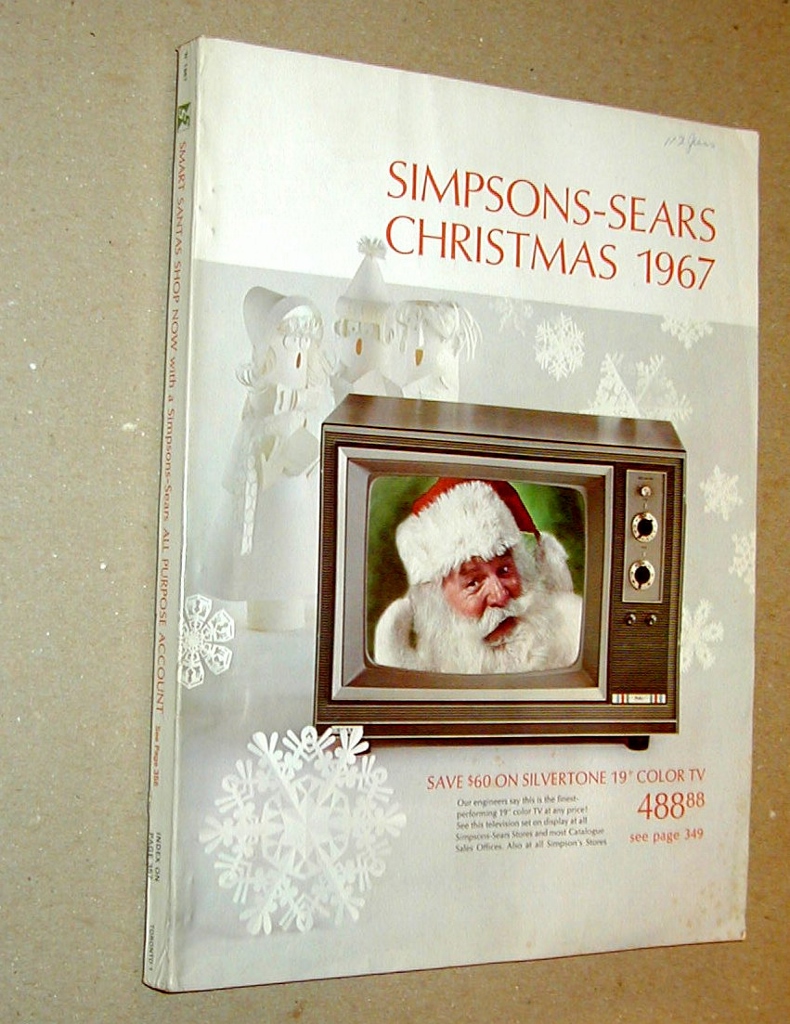
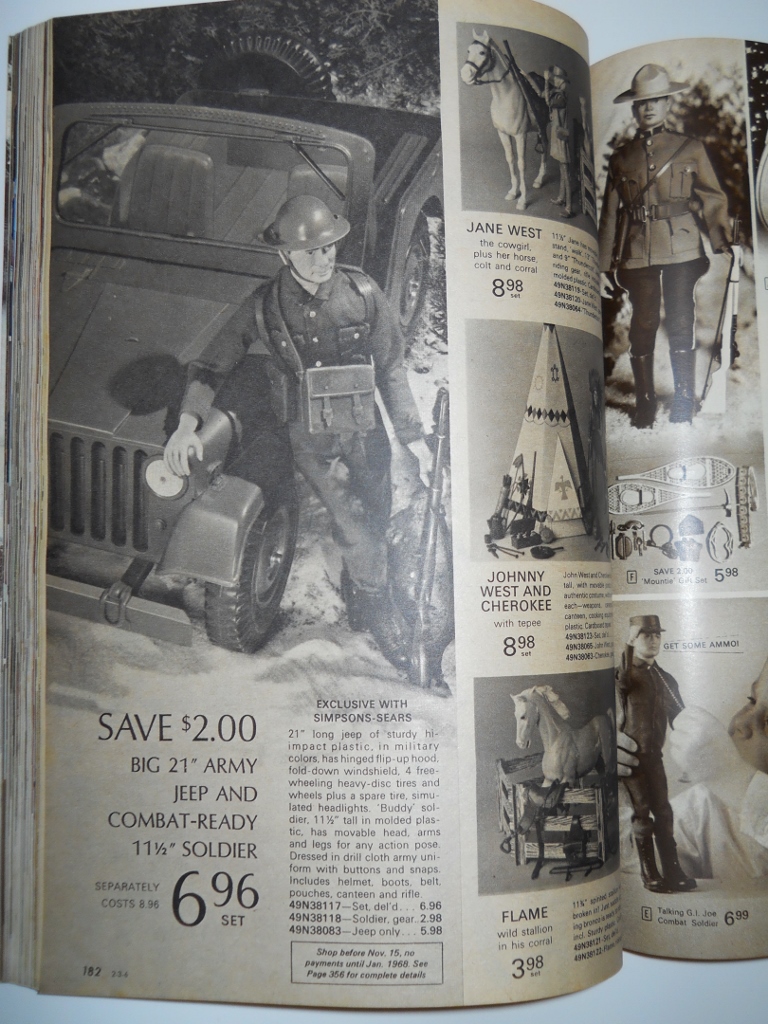
The next photo below shows both page 182 and the facing page 183 that contains GI Joe ads, including the second catalog appearance of the GI Joe Mountie.

The entire text of the Simpsons-Sears ad for the Marx Canadian Buddy figure reads as follows:
"SAVE $2.00, BIG 21" ARMY JEEP AND COMBAT-READY 11 1/2" SOLDIER, SEPARATELY COSTS 8.96, 6.96 SET, EXCLUSIVE WITH SIMPSONS-SEARS, 21" long jeep of sturdy hi-impact plastic in military colors, has hinged flip-up hood, fold-down windshield, 4 free-wheeling heavy-disc tires and wheels plus a spare tire, simulated headlights. "Buddy" soldier, 11 1/2" tall in molded plastic, has movable head, arms and legs for any action pose. Dressed in drill cloth army uniform with buttons and snaps. Includes helmet, boots, belt, pouches, canteen and rifle. (Sears stock numbers) 49N38117 - Set, del'd . . . 6.96; (#) 49N38118 - Soldier, gear . . . 2.98; (#) 49N38083 - Jeep only . . . 5.98."
On page 167 of the Toy, Doll and Games Section of the catalog, it also states "SAVE THIS CATALOGUE - ALL TOYS AVAILABLE UNTIL JULY 2, 1968."
This wording would lead us to believe that the Canadian Buddy figure would have been available to consumers until at least July 2, 1968, and likely somewhere beyond that date until the existing supply of figures ran out. The Christmas catalog would have been available as early as October or November of 1967 and, thus, the Canadian Buddy's total retail life was likely just a little over, or a little under, one year in duration.
Selling Off Remaining Stock in 1968
Simpsons-Sears would have been faced with selling off the remaining stock of Canadian Buddy figures after the July 2, 1968 guaranteed product stocking date expired. However, similar with other store "exclusive" dolls and action figures that are terminated, suppliers aren't always able to continue to supply each and every clothing, equipment and/or accessory component along with the figure orders that had previously been committed to by the store. In these circumstances, it is common for the store, or the manufacturer, to occasionally "substitute" a part, or parts, of the original set with other similar items.
In the case of Marx Buddy, the All Canadian Fighter, he proved not to be an exception to this rule, either.
The Final Issue of the Marx Buddy's Clothing and Equipment
As remaining stocks wound down, Simpsons-Sears and/or Marx Canada still had fair number of the Marx Buddy action figures available in the later part of 1968, along with the soft black combat boots, which were likely produced in fairly large production runs. However, the uniforms (which had to be painstakingly hand-sewn, right down to the tiny tan buttons) and the other green plastic pieces had been diminished to a large degree by the retail sales of existing figures up to that point in time. As a result, Simpsons-Sears was faced with having to move the remaining supplies of figures and boots to the marketplace, yet sans the shirt, pants, belt and other features of the action figure.
The solution was to check with the Hong Kong supplier for possible substitutes, as opposed to ordering a new production run of the Canadian uniforms simply to facilitate moving the final inventory of figures. As a result, many of the 1968 figures did not come with the full array of accessories, rather they were simply dressed in an "Army" style shirt and pants set. These tail-end uniforms were labelled "All American Fighters, by Marx, Hong Kong" and were likely produced simply to clothe the final batches of both the All Canadian Fighters and the All American Fighters since both action figure series were quickly drawing to a close.
The text portion of the embroidered shirt tags was sewn in with reddish lettering, as opposed to the earlier black thread. The pants contained a paper Marx label showing Hong Kong as the country of manufacture. The following pictures illustrate this.
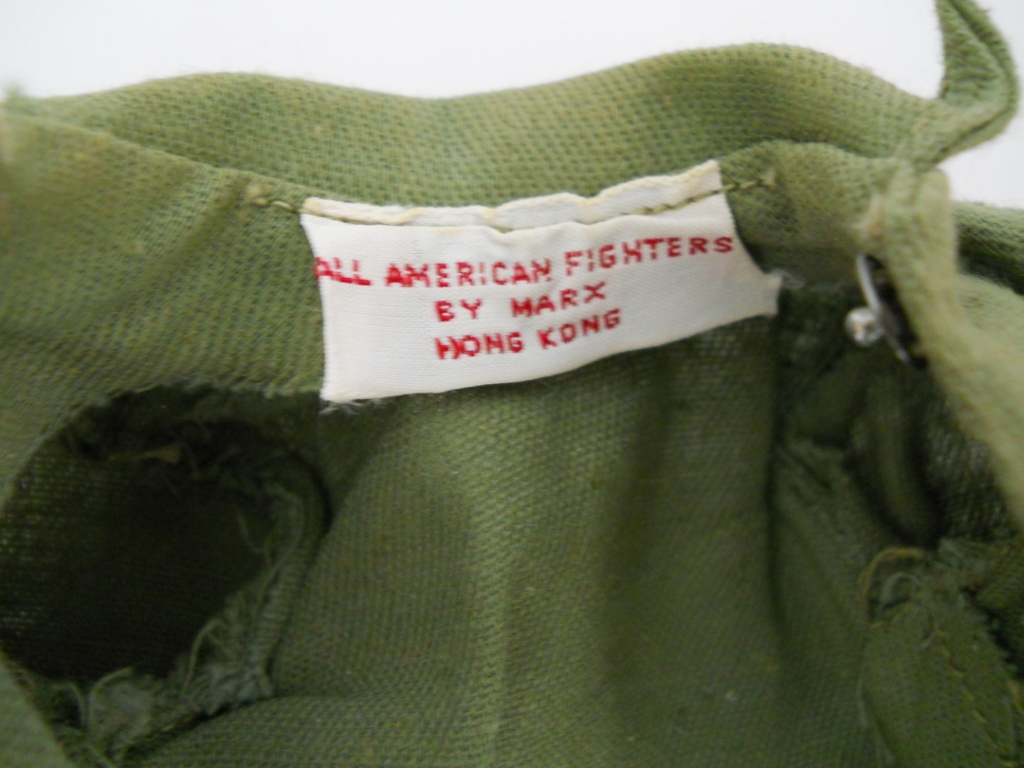
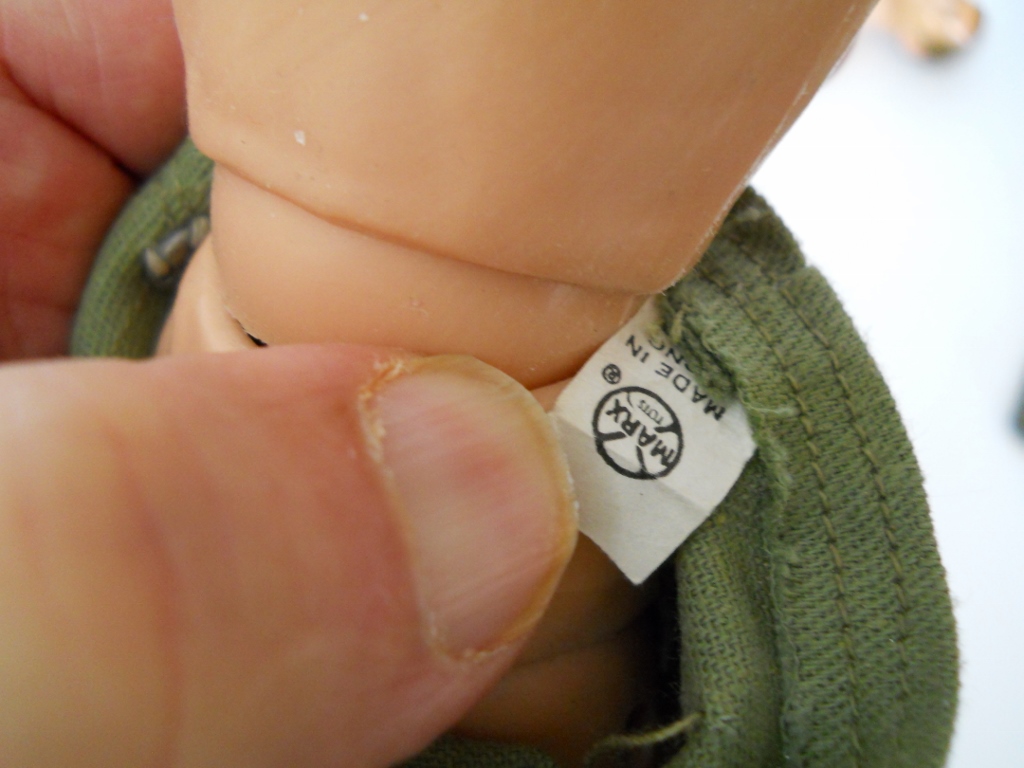
Not only were the final shirt and pants sets marked "All American Fighters," as opposed to the earlier "All British Fighters" name tags, but the cloth fabric of the uniform was dyed in a much brighter green color than the previous olive-drab shade. In fact, these final issue uniforms looked very similar to the bright green Adventure Team Commander and Man of Action uniforms of 1970's fuzzy haired GI Joes. The picture to the far right below shows the uniformed figure next to an olive-drab All Canadian Fighter and an olive-drab standard All American Fighter soldier uniform.


Sometimes a random assortment of the remaining green plastic accessories would be included in with these figures, and at other times not. It all depended upon which items remained in stock. The black boots however were guaranteed to be present. The two photos below show the same boots as the first-run figures and display the raised heels on them from a bottom view.
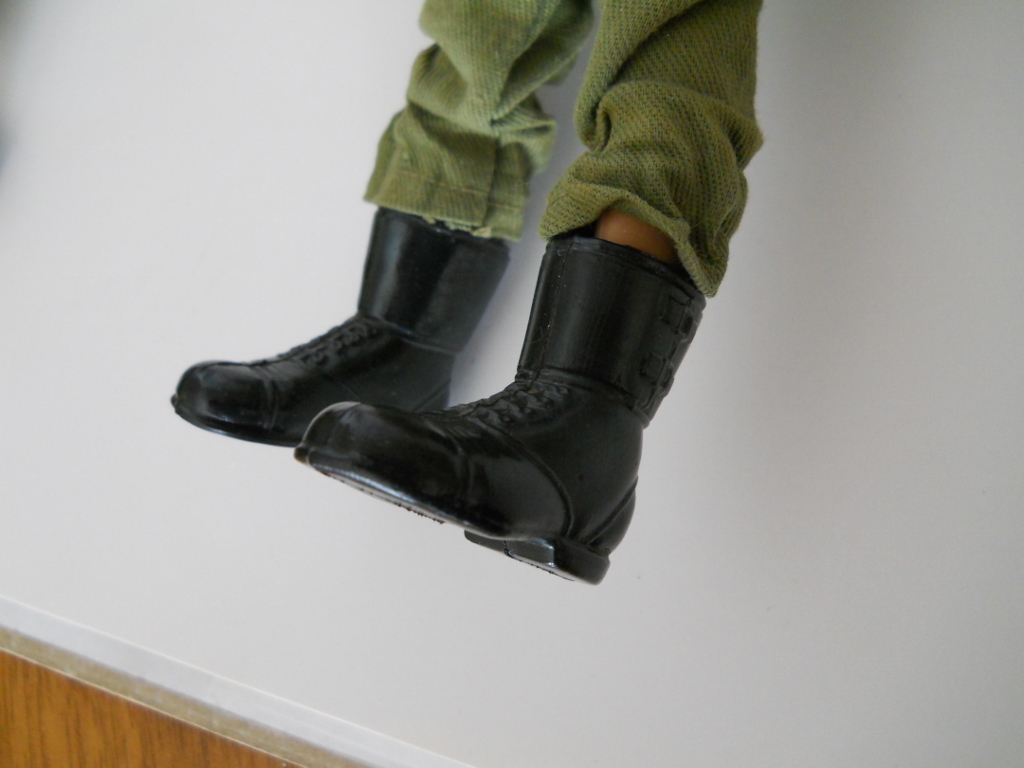

Most of the final issues of the Marx Canadian Buddy figures were painted a little different than their 1967 predecessors. The photos below show an early 1967 All Canadian Fighter in front of a late 1968 All Canadian Fighter. Note that the hair on the 1968 figure tends to be more "reddish" (similar to AAF figures) than the original 1967 issued figure. Still the whites of the eyes remain painted. The lips however are now a more realistic shade of pink.
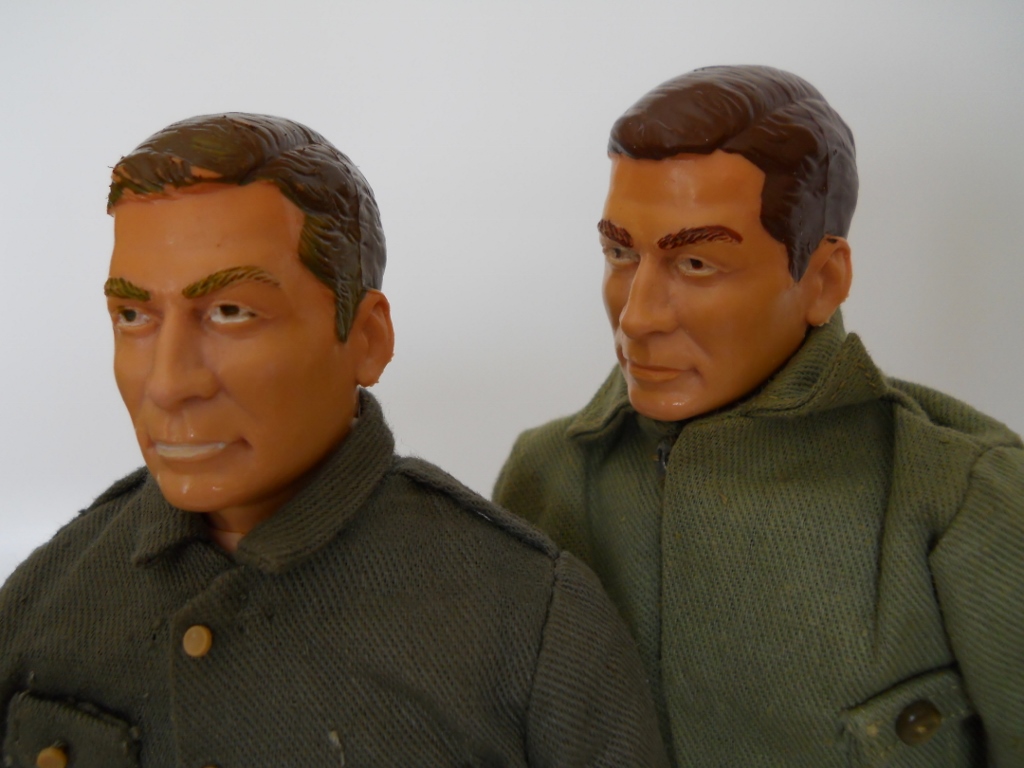

These were the only two variations of the All Canadian Fighter figure as the remaining stock would have been diminished near the end of 1968 and his short 1-year reign would have come to an abrupt end.
Marx General Eisenhower, the End of the Series
At some point in time, likely shortly after the demise of the All Canadian Fighter, Marx made one more stab at trying to continue producing 12-inch military action figures with full body articulation. Their final effort was in the form of the Marx General Eisenhower 12-inch figure. Although Eisenhower's uniform was of very good quality, and his facial sculpting was excellent, his body parts left much to be desired. The limbs were all made of a much cheaper plastic molding than either the All American Fighter or the All Canadian Fighter, which were both of much superior quality. In addition, the body parts were joined with inferior metallic rivets, as opposed to the long-lasting metal rivets of the former figures. Clearly, the era for Marx to try to produce a GI Joe style action figure had come to an end.
Below is a photo of the Marx General Eisenhower figure with his original box. Note that there was no indication of the year of manufacture anywhere to been seen on the face or the sides of the box, casting doubt on his actual year of release. The next two photo beneath it show that both his shoes and his cap were stamped with a "Marx Toys, Made in Hong Kong" logo. This is a clear indicator that he was made during Marx's "Hong Kong" supplier period, and not the earlier "Japan" factory period. In all probability, this implies that he was likely sold in retail settings in 1968 or 1969.
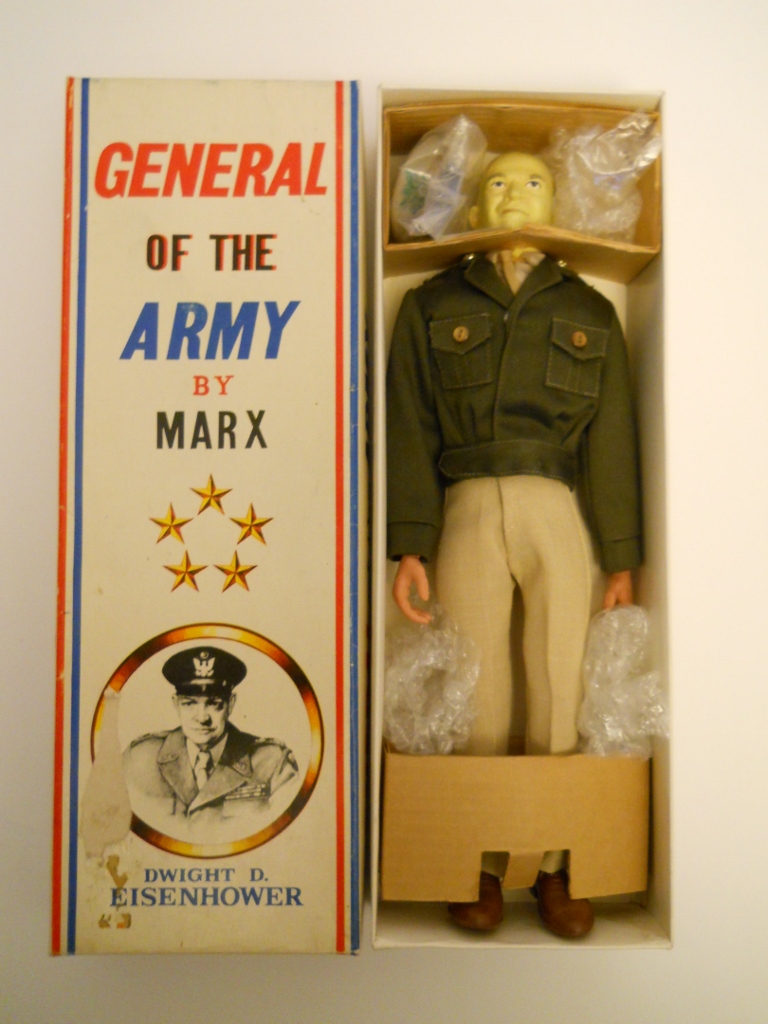
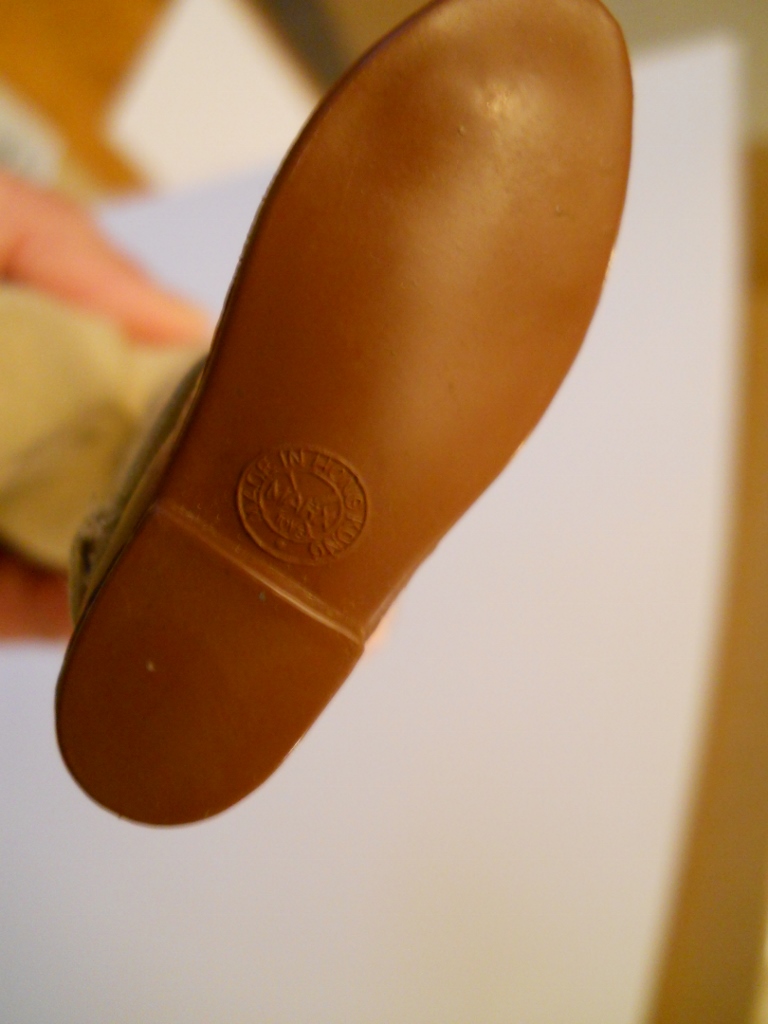
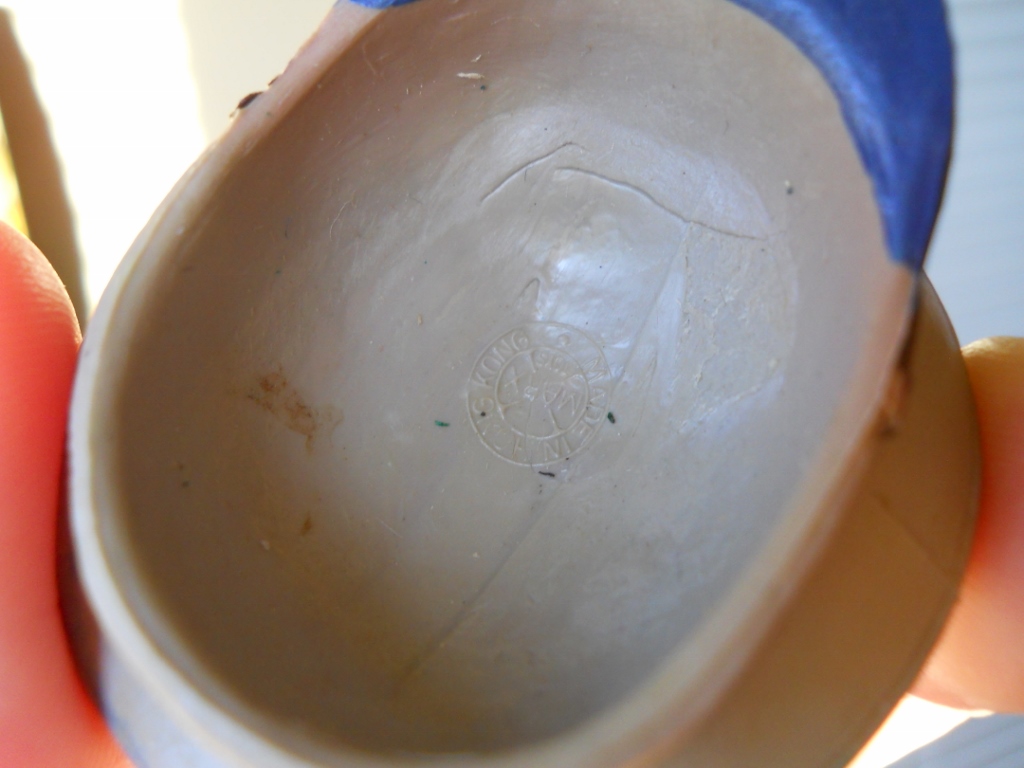
The photo below shows General Eisenhower, flanked by two Marx All Canadian Fighters.
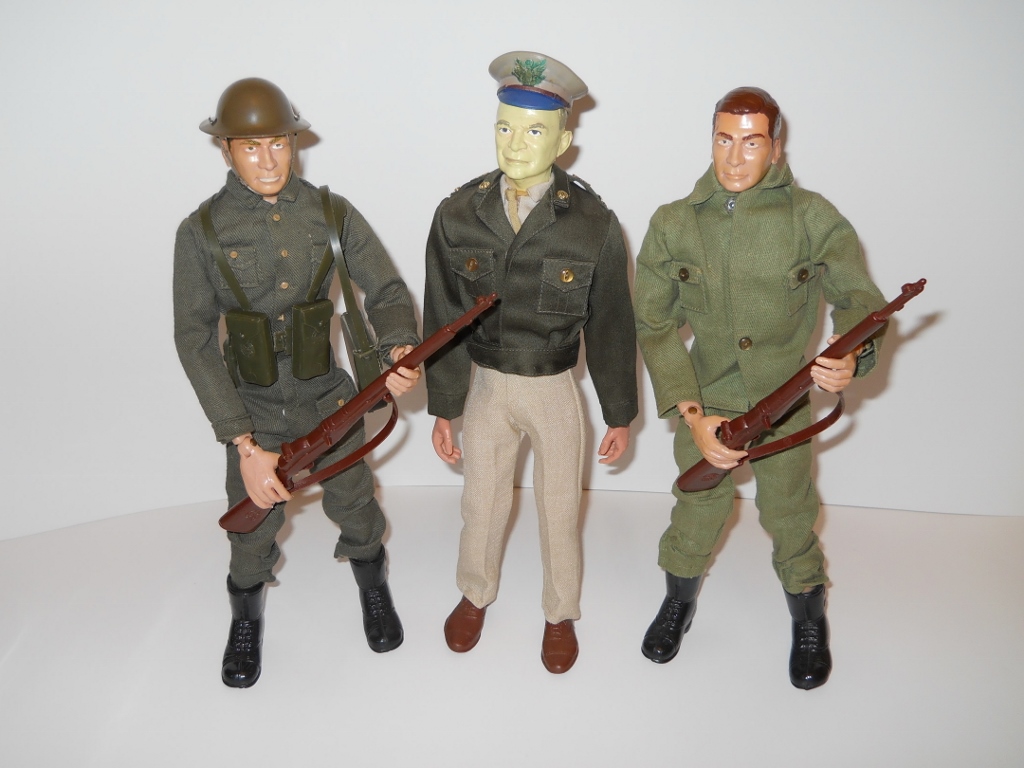
The All Canadian Fighters are prepared to serve and protect this famous WWII General (and later President of the United States). Remember, even here in Canada, we "liked Ike," too.